Energy Transition and Resilient Control for Enhancing Power Availability in Microgrids Based on North African Countries: A Review
Abstract
:Featured Application
Abstract
1. Introduction
2. Energy transition in North Africa
2.1. Introduction to North Africa’s Energy Landscape
2.2. Renewable Energy Potential
2.3. Government Initiatives and Policies
2.4. Challenges and Barriers
2.5. Role of International Collaborations
3. Structures of Microgrids
3.1. Introduction to Microgrids
3.2. Operation Modes of a Microgrid
3.3. Integration of Renewable Energy Sources
3.4. Energy Storage System
3.5. Electric Vehicles (EVs) and Green Hydrogen Integration
3.6. Role of Fuel Cells
4. Review of Microgrid Control and Design
4.1. Microgrid Control Methods
4.2. Hierarchical Control Structure in Microgrids
4.3. Primary Control Level
4.3.1. Grid following Control
4.3.2. Grid Forming Control
- -
- Single grid forming unit:
- -
- Multiple grids forming units:
4.4. Secondary Control Level
4.4.1. Centralized Secondary Control
4.4.2. Distributed Secondary Control
4.5. Tertiary Control Level
4.6. Conventional and Advanced Control Techniques in Microgrids
4.6.1. Conventional Control Method Using PI/PID
4.6.2. Linear Quadratic Control
4.6.3. Sliding Mode Control
4.6.4. Model Predictive Control (MPC)
4.6.5. AI-Based Control Techniques
- (a)
- Particle Swarm Optimization (PSO)
- (b)
- Fuzzy Logic Control (FL)
- (c)
- Neural Networks
4.6.6. Adaptive Control Techniques
4.6.7. Robust H-Infinity Control
4.6.8. Active Disturbance Rejection Control (ADRC)
4.7. Comparison Analysis of the Control Techniques
4.8. Resilient Control Strategies for Microgrids
- -
- Disturbance tolerance: The control system should be able to maintain stability and performance when perturbations are present, like sudden variations in load or generation, faults, and weather events, by using control techniques such as ADRC, droop control, H-infinity, and nonlinear controls [134,135,137,138,164].
- -
- Adaptability: The control system should be able to adapt to changing operating conditions and uncertainties, such as variations in renewable energy generation and load patterns, where adaptive control algorithms are suitable because they are continuously adjusting their parameters based on real-time system data to maintain stability and performance despite changing conditions [132,133].
- -
- Cybersecurity: The control system must be designed to withstand cyberattacks, such as unauthorized access, data manipulation, and malware infections. Some researchers have proposed a cybersecurity protocol to protect the control system against cyberattacks by implementing measures such as encryption, access control, and intrusion detection [165,166].
- -
- Fault-tolerant and self-healing: The control system should have mechanisms to detect and isolate faults and to restore normal operation following disruptions. Various techniques were used in this context. For instance, in the research conducted by T. Wang et al. [167], they developed a model-based fault detection and isolation algorithm in DC microgrids in order to identify and isolate faults in the MGs, preventing them from propagating and causing widespread disruption.
- -
- Decision-making under uncertainty: The control system must be able to make informed decisions under conditions of uncertainty when complete information about the system’s state or future events is not available. The authors in [167] have proposed a three-stage decision-making approach that considers the spatial uncertainty of failure probabilities, which are represented by probability distributions, and weights the loss of performance due to preventive and post-event measures.
5. Control Methods Applied to Microgrids Developed in the North African Region
6. Conclusions
Author Contributions
Funding
Institutional Review Board Statement
Informed Consent Statement
Conflicts of Interest
Nomenclature
| BC | Backstepping control |
| DG | Distributed generation |
| DER | Distributed energy resource |
| ESS | Energy storage system |
| FLC | Fuzzy logic control |
| GA | Genetic algorithm |
| GHG | Greenhouse gas emissions |
| MG | Microgrid |
| MPC | Model predictive control |
| NN | Neural network |
| P | Proportional |
| PCC | Point of common coupling |
| PID | Proportional integral derivative |
| PR | Proportional resonant |
| PSO | practical swarm optimization |
| SAPF | Shunt Active Power Filter |
| SM | Sliding mode |
| V2G | Vehicle to Grid |
| V2H | Vehicle to Home |
References
- Fuchs, E.F.; Masoum, M.A.S. Chapter 1—Introduction to power quality. In Power Quality in Power Systems, Electrical Machines, and Power-Electronic Drives, 3rd ed.; Fuchs, E.F., Masoum, M.A.S., Eds.; Academic Press: Cambridge, MA, USA, 2023; pp. 1–97. ISBN 978-0-12-817856-0. [Google Scholar] [CrossRef]
- Ayetor, G.K.; Mashele, J.; Mbonigaba, I. The progress toward the transition to electromobility in Africa. Renew. Sustain. Energy Rev. 2023, 183, 113533. [Google Scholar] [CrossRef]
- van Wijk, A.; Wouters, F. Hydrogen–The Bridge Between Africa and Europe. In Shaping an Inclusive Energy Transition; Weijnen, M.P.C., Lukszo, Z., Farahani, S., Eds.; Springer International Publishing: Cham, Switzerland, 2021; pp. 91–119. ISBN 978-3-030-74586-8. [Google Scholar] [CrossRef]
- Owen-Burge, C. African Green Hydrogen Alliance Launches with Eyes on Becoming a Clean Energy Leader. Available online: https://climatechampions.unfccc.int/african-green-hydrogen-alliance-launches-with-eyes-on-becoming-a-clean-energy-leader/ (accessed on 9 December 2023).
- Nfaoui, H. Wind Energy in Morocco: Resources, Potential, and Progress. In The Age of Wind Energy: Progress and Future Directions from a Global Perspective; Sayigh, A., Milborrow, D., Eds.; Springer International Publishing: Cham, Switzerland, 2020; pp. 219–282. ISBN 978-3-030-26446-8. [Google Scholar] [CrossRef]
- Solar Resource Maps of Tunisia. Available online: https://solargis.com/maps-and-gis-data/download/tunisia (accessed on 29 June 2024).
- ANME. Atlas Éolien. Available online: https://www.anme.tn/fr/projets/eolien/atlas-eolien (accessed on 1 July 2024).
- Centre de Développement des Energies Renouvelables. Available online: https://www.cder.dz/ (accessed on 21 June 2024).
- Khalifa, Y.; Syour, S.; Alargt, F. Optimal Design of a Hybrid Renewable Energy System Powering Mobile Radio Base Station in Libya. In Proceedings of the 2021 IEEE 1st International Maghreb Meeting of the Conference on Sciences and Techniques of Automatic Control and Computer Engineering MI-STA, Tripoli, Libya, 25–27 May 2021; pp. 423–429. [Google Scholar] [CrossRef]
- Solar Resource Maps of Egypt. Available online: https://solargis.com/maps-and-gis-data/download/egypt (accessed on 1 July 2024).
- Shaaban, M.; Scheffran, J.; Elsobki, M.S.; Azadi, H. A Comprehensive Evaluation of Electricity Planning Models in Egypt: Optimization versus Agent-Based Approaches. Sustainability 2022, 14, 1563. [Google Scholar] [CrossRef]
- Realizing North Africa’s Green Hydrogen Potential—Atlantic Council. Available online: https://www.atlanticcouncil.org/blogs/energysource/realizing-north-africas-green-hydrogen-potential/ (accessed on 16 June 2024).
- Uddin, M.; Mo, H.; Dong, D.; Elsawah, S.; Zhu, J.; Guerrero, J.M. Microgrids: A review, outstanding issues and future trends. Energy Strategy Rev. 2023, 49, 101127. [Google Scholar] [CrossRef]
- Marimuthu, R. Review on advanced control techniques for microgrids. Energy Rep. 2023, 10, 3054–3072. [Google Scholar] [CrossRef]
- Musleh, A.S.; Chen, G.; Dong, Z.Y. A Survey on the Detection Algorithms for False Data Injection Attacks in Smart Grids. IEEE Trans. Smart Grid 2020, 11, 2218–2234. [Google Scholar] [CrossRef]
- Hamidieh, M.; Ghassemi, M. Microgrids and Resilience: A Review. IEEE Access 2022, 10, 106059–106080. [Google Scholar] [CrossRef]
- IEA. Clean Energy Transitions in North Africa; IEA: Paris, France, 2020. [Google Scholar]
- Adly, A. Egypt’s Oil Dependency and Political Discontent. Available online: https://carnegie-mec.org/2016/08/02/egypt-s-oil-dependency-and-political-discontent-pub-64224 (accessed on 8 December 2023).
- 468 Energy Resource Guide—Algeria—Renewable Energy. Available online: https://www.trade.gov/energy-resource-guide-algeria-renewable-energy (accessed on 8 December 2023).
- Planning and Prospects for Renewable Power: North Africa. Available online: https://www.irena.org/Publications/2023/Jan/Planning-and-prospects-for-renewable-power-North-Africa (accessed on 8 December 2023).
- European Commission; Joint Research Centre. CO2 Emissions of All World Countries: JRC/IEA/PBL 2022 Report; Publications Office of the European Union: Luxembourg, 2022; Available online: https://data.europa.eu/doi/10.2760/730164 (accessed on 9 December 2023).
- North Africa Overview Report 2023.pdf. Available online: https://www.egypt-energy.com/content/dam/markets/emea/egypt-energy/en/docs/north-africa-2023-overview-report/North%20Africa%20Overview%20Report%202023.pdf (accessed on 15 June 2024).
- Arab Center Washington DC. Green Power Politics in North African Countries: Continuity or Change? Available online: https://arabcenterdc.org/resource/green-power-politics-in-north-african-countries-continuity-or-change/ (accessed on 8 December 2023).
- Santamarta, J. Noor Ouarzazate Solar Complex in Morocco, World’s Largest Concentrated Solar Power Plant. HELIOSCSP. Available online: https://helioscsp.com/noor-ouarzazate-solar-complex-in-morocco-worlds-largest-concentrated-solar-power-plant/ (accessed on 8 December 2023).
- Ourya, I.; Nabil, N.; Abderafi, S.; Boutammachte, N.; Rachidi, S. Assessment of green hydrogen production in Morocco, using hybrid renewable sources (PV and wind). Int. J. Hydrogen Energy 2023, 48, 37428–37442. [Google Scholar] [CrossRef]
- The Climate Change Performance Index 2023 | NewClimate Institute. Available online: https://newclimate.org/resources/publications/the-climate-change-performance-index-2023 (accessed on 8 December 2023).
- The German-Tunisian Energy Partnership. Available online: https://www.energypartnership-tunisia.org/home/ (accessed on 8 December 2023).
- Cardinale, R. From natural gas to green hydrogen: Developing and repurposing transnational energy infrastructure connecting North Africa to Europe. Energy Policy 2023, 181, 113623. [Google Scholar] [CrossRef]
- Libya to Generate 20% of Its Electricity from Renewable Energy by 2035 | The Libya Observer. Available online: https://libyaobserver.ly/news/libya-generate-20-its-electricity-renewable-energy-2035 (accessed on 8 December 2023).
- Mauritania. Green Hydrogen Organisation. Available online: http://gh2.org/countries/mauritania (accessed on 8 December 2023).
- MASEN—Offre Maroc Hydrogène Vert. Available online: https://www.masen.ma/en/green-hydrogen-moroccan-offer (accessed on 21 June 2024).
- Mining in North Africa. Available online: https://projectsiq.co.za/mining-in-north-africa.htm (accessed on 21 June 2024).
- Tsebia, M.; Bentarzi, H. Reduction in the use of fossil fuels by improving the interconnection power system oscillation. Int. J. Power Electron. Drive Syst. 2023, 14, 395–404. [Google Scholar] [CrossRef]
- COP28: Morocco, Portugal Sign Joint Declaration on Electricity Interconnection Project|MapNews. Available online: https://www.mapnews.ma/en/actualites/economy/cop28-morocco-portugal-sign-joint-declaration-electricity-interconnection-project (accessed on 8 December 2023).
- Giz. Diese Seite Konnte Leider Nicht Gefunden Werden/Sorry, the Page was Not Found. Available online: https://www.giz.de/en/worldwide/57153.htmlhttps://www.giz.de/en/worldwide/57157.html (accessed on 8 December 2023).
- Morocco’s Nuclear Option: Russian vs. US Technological Cooperation to Power Its Water Scarcity Solutions. Middle East Institute. Available online: https://www.mei.edu/publications/moroccos-nuclear-option-russian-vs-us-technological-cooperation-power-its-water (accessed on 8 December 2023).
- El Dabaa Nuclear Power Plant. Power Technology. Available online: https://www.power-technology.com/projects/el-dabaa-nuclear-power-plant/ (accessed on 8 December 2023).
- Morocco-UK Power Project. Xlinks. Available online: https://xlinks.co/morocco-uk-power-project/ (accessed on 8 December 2023).
- Yoldaş, Y.; Önen, A.; Muyeen, S.M.; Vasilakos, A.V.; Alan, İ. Enhancing smart grid with microgrids: Challenges and opportunities. Renew. Sustain. Energy Rev. 2017, 72, 205–214. [Google Scholar] [CrossRef]
- Abbasi, M.; Abbasi, E.; Li, L.; Aguilera, R.P.; Lu, D.; Wang, F. Review on the Microgrid Concept, Structures, Components, Communication Systems, and Control Methods. Energies 2023, 16, 484. [Google Scholar] [CrossRef]
- Modu, B.; Abdullah, M.P.; Sanusi, M.A.; Hamza, M.F. DC-based microgrid: Topologies, control schemes, and implementations. Alex. Eng. J. 2023, 70, 61–92. [Google Scholar] [CrossRef]
- Jain, M.; Gupta, S.; Masand, D.; Agnihotri, G.; Jain, S. Real-Time Implementation of Islanded Microgrid for Remote Areas. J. Control Sci. Eng. 2016, 2016, 5710950. [Google Scholar] [CrossRef]
- Lidula, N.W.A.; Rajapakse, A.D. Microgrids research: A review of experimental microgrids and test systems. Renew. Sustain. Energy Rev. 2011, 15, 186–202. [Google Scholar] [CrossRef]
- Basso, T.S.; DeBlasio, R. IEEE 1547 series of standards: Interconnection issues. IEEE Trans. Power Electron. 2004, 19, 1159–1162. [Google Scholar] [CrossRef]
- Mahmoud, M.S. Microgrid Control Problems and Related Issues. In Microgrid; Elsevier: Amsterdam, The Netherlands, 2017; pp. 1–42. ISBN 978-0-08-101753-1. [Google Scholar] [CrossRef]
- Vijay, A.s.; Doolla, S.; Chandorkar, M.C. Unbalance mitigation strategies in microgrids. IET Power Electron. 2020, 13, 1687–1710. [Google Scholar] [CrossRef]
- Liu, X.; Su, B. Microgrids—An integration of renewable energy technologies. In Proceedings of the 2008 China International Conference on Electricity Distribution, Guangzhou, China, 10–13 December 2008; pp. 1–7. [Google Scholar] [CrossRef]
- Mutarraf, M.U.; Terriche, Y.; Niazi, K.A.K.; Vasquez, J.C.; Guerrero, J.M. Energy Storage Systems for Shipboard Microgrids—A Review. Energies 2018, 11, 3492. [Google Scholar] [CrossRef]
- Mitali, J.; Dhinakaran, S.; Mohamad, A.A. Energy storage systems: A review. Energy Storage Sav. 2022, 1, 166–216. [Google Scholar] [CrossRef]
- Das, C.K.; Bass, O.; Kothapalli, G.; Mahmoud, T.S.; Habibi, D. Overview of energy storage systems in distribution networks: Placement, sizing, operation, and power quality. Renew. Sustain. Energy Rev. 2018, 91, 1205–1230. [Google Scholar] [CrossRef]
- Guney, M.S.; Tepe, Y. Classification and assessment of energy storage systems. Renew. Sustain. Energy Rev. 2017, 75, 1187–1197. [Google Scholar] [CrossRef]
- IEA. Transport—Energy System. Available online: https://www.iea.org/energy-system/transport (accessed on 12 December 2023).
- Giz. Decarbonising Morocco’s Transport System. Available online: https://www.giz.de/en/worldwide/129440.html (accessed on 10 December 2023).
- Chettah, S.E.; Nait Amar, N. Towards a sustainable transport in algeria: The requisite of energy transition in the road transport sector. Sci. J. Silesian Univ. Technol. Ser. Transp. 2021, 112, 33–49. [Google Scholar] [CrossRef]
- New Modes of Transport in Tunisia. Houloul. Available online: https://houloul.org/en/2020/12/13/new-modes-of-transport-in-tunisia/ (accessed on 10 December 2023).
- Elmansouri, O.; Almhroog, A.; Badi, I. Urban transportation in Libya: An overview. Transp. Res. Interdiscip. Perspect. 2020, 8, 100161. [Google Scholar] [CrossRef]
- Moussa, R.R. Reducing carbon emissions in Egyptian roads through improving the streets quality. Env. Dev Sustain 2023, 25, 4765–4786. [Google Scholar] [CrossRef]
- Guerir, B. IRESEN—Institut de Recherche en Énergie Solaire et Énergies Nouvelles. Available online: https://iresen.org/presentation-de-la-1ere-borne-de-recharge-marocaine-ismart/ (accessed on 10 December 2023).
- ALM. Borne de Recharge Pour Véhicules Electriques: Ismart, une Innovation 100% Marocaine. Aujourd’hui le Maroc. Available online: https://aujourdhui.ma/automobile/borne-de-recharge-pour-vehicules-electriques-ismart-une-innovation-100-marocaine (accessed on 10 December 2023).
- Charging Stations’ Statistics. Available online: https://chargemap.com/about/stats/morocco (accessed on 10 December 2023).
- Lux, B.; Gegenheimer, J.; Franke, K.; Sensfuß, F.; Pfluger, B. Supply curves of electricity-based gaseous fuels in the MENA region. Comput. Ind. Eng. 2021, 162, 107647. [Google Scholar] [CrossRef]
- Li, Z.; Zheng, Z.; Xu, L.; Lu, X. A review of the applications of fuel cells in microgrids: Opportunities and challenges. BMC Energy 2019, 1, 8. [Google Scholar] [CrossRef]
- Tan, S.; Guerrero, J.M.; Xie, P.; Han, R.; Vasquez, J.C. Brief Survey on Attack Detection Methods for Cyber-Physical Systems. IEEE Syst. J. 2020, 14, 5329–5339. [Google Scholar] [CrossRef]
- Hosseinzadeh, M.; Salmasi, F.R. Fault-Tolerant Supervisory Controller for a Hybrid AC/DC Micro-Grid. IEEE Trans. Smart Grid 2018, 9, 2809–2823. [Google Scholar] [CrossRef]
- Srikanth, T.; Chitra Selvi, S. A novel centralized supervisory with distributed control system-based microgrid. Automatika 2022, 63, 482–495. [Google Scholar] [CrossRef]
- Veerasamy, V.; Hu, Z.; Qiu, H.; Murshid, S.; Gooi, H.B.; Nguyen, H.D. Blockchain-enabled peer-to-peer energy trading and resilient control of microgrids. Appl. Energy 2024, 353, 122107. [Google Scholar] [CrossRef]
- Zuo, K.; Wu, L. A review of decentralized and distributed control approaches for islanded microgrids: Novel designs, current trends, and emerging challenges. Electr. J. 2022, 35, 107138. [Google Scholar] [CrossRef]
- Papadaskalopoulos, D.; Pudjianto, D.; Strbac, G. Decentralized Coordination of Microgrids With Flexible Demand and Energy Storage. IEEE Trans. Sustain. Energy 2014, 5, 1406–1414. [Google Scholar] [CrossRef]
- Vijayaragavan, R.; Umamaheswari, B. Decentralized control of autonomous DC microgrids with composite loads: An approach using optimal control. Electr. Eng. 2021, 103, 2871–2885. [Google Scholar] [CrossRef]
- Bidram, A.; Davoudi, A. Hierarchical Structure of Microgrids Control System. IEEE Trans. Smart Grid 2012, 3, 1963–1976. [Google Scholar] [CrossRef]
- Wang, G.; Wang, X.; Wang, F.; Han, Z. Research on Hierarchical Control Strategy of AC/DC Hybrid Microgrid Based on Power Coordination Control. Appl. Sci. 2020, 10, 7603. [Google Scholar] [CrossRef]
- Vandoorn, T.L.; Vasquez, J.C.; De Kooning, J.; Guerrero, J.M.; Vandevelde, L. Microgrids: Hierarchical Control and an Overview of the Control and Reserve Management Strategies. IEEE Ind. Electron. Mag. 2013, 7, 42–55. [Google Scholar] [CrossRef]
- Oubail, Y.; Boulakhbar, M.; Aboudrar, I.; Elmoutawakil Alaoui, M.R.; Elmahni, L. Renewable Energy Sources Integration in a Microgrid Control System: Overview and Perspective. In Digital Technologies and Applications; Motahhir, S., Bossoufi, B., Eds.; In Lecture Notes in Networks and Systems; Springer International Publishing: Cham, Switzerland, 2022; pp. 552–561. [Google Scholar] [CrossRef]
- Shirkhani, M.; Tavoosi, J.; Danyali, S.; Sarvenoee, A.K.; Abdali, A.; Mohammadzadeh, A.; Zhang, C. A review on microgrid decentralized energy/voltage control structures and methods. Energy Rep. 2023, 10, 368–380. [Google Scholar] [CrossRef]
- Shahzad, S.; Abbasi, M.A.; Ali, H.; Iqbal, M.; Munir, R.; Kilic, H. Possibilities, Challenges, and Future Opportunities of Microgrids: A Review. Sustainability 2023, 15, 6366. [Google Scholar] [CrossRef]
- Abhishek, A.; Ranjan, A.; Devassy, S.; Kumar Verma, B.; Ram, S.K.; Dhakar, A.K. Review of hierarchical control strategies for DC microgrid. IET Renew. Power Gener. 2020, 14, 1631–1640. [Google Scholar] [CrossRef]
- Sensors | Free Full-Text | Moving Microgrid Hierarchical Control to an SDN-Based Kubernetes Cluster: A Framework for Reliable and Flexible Energy Distribution. Available online: https://www.mdpi.com/1424-8220/23/7/3395 (accessed on 2 December 2023).
- Ishaq, S.; Khan, I.; Rahman, S.; Hussain, T.; Iqbal, A.; Elavarasan, R.M. A review on recent developments in control and optimization of micro grids. Energy Rep. 2022, 8, 4085–4103. [Google Scholar] [CrossRef]
- Bouzid, A.M.; Guerrero, J.M.; Cheriti, A.; Bouhamida, M.; Sicard, P.; Benghanem, M. A survey on control of electric power distributed generation systems for microgrid applications. Renew. Sustain. Energy Rev. 2015, 44, 751–766. [Google Scholar] [CrossRef]
- Rocabert, J.; Luna, A.; Blaabjerg, F.; Rodríguez, P. Control of Power Converters in AC Microgrids. IEEE Trans. Power Electron. 2012, 27, 4734–4749. [Google Scholar] [CrossRef]
- Palizban, O.; Kauhaniemi, K. Hierarchical control structure in microgrids with distributed generation: Island and grid-connected mode. Renew. Sustain. Energy Rev. 2015, 44, 797–813. [Google Scholar] [CrossRef]
- Hong, C.-M.; Ou, T.-C.; Lu, K.-H. Development of intelligent MPPT (maximum power point tracking) control for a grid-connected hybrid power generation system. Energy 2013, 50, 270–279. [Google Scholar] [CrossRef]
- Blaabjerg, F.; Teodorescu, R.; Liserre, M.; Timbus, A.V. Overview of Control and Grid Synchronization for Distributed Power Generation Systems. IEEE Trans. Ind. Electron. 2006, 53, 1398–1409. [Google Scholar] [CrossRef]
- Asadi, Y.; Eskandari, M.; Mansouri, M.; Savkin, A.V.; Pathan, E. Frequency and Voltage Control Techniques through Inverter-Interfaced Distributed Energy Resources in Microgrids: A Review. Energies 2022, 15, 8580. [Google Scholar] [CrossRef]
- Costa, I.D.L.; Brandao, D.I.; Matakas Junior, L.; Simões, M.G.; Morais, L.M.F. Analysis of Stationary- and Synchronous-Reference Frames for Three-Phase Three-Wire Grid-Connected Converter AC Current Regulators. Energies 2021, 14, 8348. [Google Scholar] [CrossRef]
- Sen, S.; Kumar, V. Microgrid control: A comprehensive survey. Annu. Rev. Control 2018, 45, 118–151. [Google Scholar] [CrossRef]
- Rodriguez, P.; Candela, I.; Citro, C.; Rocabert, J.; Luna, A. Control of grid-connected power converters based on a virtual admittance control loop. In Proceedings of the 2013 15th European Conference on Power Electronics and Applications (EPE), Lille, France, 2–6 September 2013; pp. 1–10. [Google Scholar]
- Guerrero, J.M.; Hang, L.; Uceda, J. Control of Distributed Uninterruptible Power Supply Systems. IEEE Trans. Ind. Electron. 2008, 55, 2845–2859. [Google Scholar] [CrossRef]
- Gurugubelli, V.; Ghosh, A.; Panda, A.K. Parallel inverter control using different conventional control methods and an improved virtual oscillator control method in a standalone microgrid. Prot. Control Mod. Power Syst. 2022, 7, 27. [Google Scholar] [CrossRef]
- Salem, Q.; Aljarrah, R.; Karimi, M.; Al-Quraan, A. Grid-Forming Inverter Control for Power Sharing in Microgrids Based on P/f and Q/V Droop Characteristics. Sustainability 2023, 15, 11712. [Google Scholar] [CrossRef]
- Serban, I.; Ion, C.P. Microgrid control based on a grid-forming inverter operating as virtual synchronous generator with enhanced dynamic response capability. Int. J. Electr. Power Energy Syst. 2017, 89, 94–105. [Google Scholar] [CrossRef]
- Palizban, O.; Kauhaniemi, K.; Guerrero, J.M. Microgrids in active network management—Part I: Hierarchical control, energy storage, virtual power plants, and market participation. Renew. Sustain. Energy Rev. 2014, 36, 428–439. [Google Scholar] [CrossRef]
- Vandoorn, T.L.; De Kooning, J.D.M.; Meersman, B.; Vandevelde, L. Review of primary control strategies for islanded microgrids with power-electronic interfaces. Renew. Sustain. Energy Rev. 2013, 19, 613–628. [Google Scholar] [CrossRef]
- Khadem, S.K.; Basu, M.; Conlon, M.F. Parallel operation of inverters and active power filters in distributed generation system—A review. Renew. Sustain. Energy Rev. 2011, 15, 5155–5168. [Google Scholar] [CrossRef]
- Li, Q.; Peng, C.; Wang, M.; Chen, M.; Guerrero, J.M.; Abbott, D. Distributed Secondary Control and Management of Islanded Microgrids via Dynamic Weights. IEEE Trans. Smart Grid 2019, 10, 2196–2207. [Google Scholar] [CrossRef]
- Vandoorn, T.L.; De Kooning, J.D.M.; Meersman, B.; Vandevelde, L. Communication-based secondary control in microgrids with voltage-based droop control. In Proceedings of the PES T&D, Orlando, FL, USA, 7–10 May 2012; pp. 1–6. [Google Scholar] [CrossRef]
- Sahoo, A.K.; Mahmud, K.; Crittenden, M.; Ravishankar, J.; Padmanaban, S.; Blaabjerg, F. Communication-Less Primary and Secondary Control in Inverter-Interfaced AC Microgrid: An Overview. IEEE J. Emerg. Sel. Top. Power Electron. 2021, 9, 5164–5182. [Google Scholar] [CrossRef]
- Shan, Y.; Ma, L.; Yu, X. Hierarchical Control and Economic Optimization of Microgrids Considering the Randomness of Power Generation and Load Demand. Energies 2023, 16, 5503. [Google Scholar] [CrossRef]
- Simpson-Porco, J.W.; Shafiee, Q.; Dörfler, F.; Vasquez, J.C.; Guerrero, J.M.; Bullo, F. Secondary Frequency and Voltage Control of Islanded Microgrids via Distributed Averaging. IEEE Trans. Ind. Electron. 2015, 62, 7025–7038. [Google Scholar] [CrossRef]
- Ait Ben Hassi, Y.A.; Hennane, Y.; Berdai, A.; Tytiuk, V. Primary and Secondary Controls with Reactive Power Sharing in Mesh Microgrids. In Proceedings of the 2022 IEEE 4th International Conference on Modern Electrical and Energy System (MEES), Kremenchuk, Ukraine, 20–23 October 2022; pp. 1–6. [Google Scholar] [CrossRef]
- Peyghami, S.; Mokhtari, H.; Blaabjerg, F. Chapter 3—Hierarchical Power Sharing Control in DC Microgrids. In Microgrid; Mahmoud, M.S., Ed.; Butterworth-Heinemann: Oxford, UK, 2017; pp. 63–100. ISBN 978-0-08-101753-1. [Google Scholar] [CrossRef]
- Nasirian, V.; Davoudi, A.; Lewis, F.L.; Guerrero, J.M. Distributed Adaptive Droop Control for DC Distribution Systems. IEEE Trans. Energy Convers. 2014, 29, 944–956. [Google Scholar] [CrossRef]
- Loh, P.C.; Blaabjerg, F.; Peyghami-Akhuleh, S.; Mokhtari, H. Distributed secondary control in DC microgrids with low-bandwidth communication link. In Proceedings of the 2016 7th Power Electronics and Drive Systems Technologies Conference (PEDSTC), Tehran, Iran, 16–18 February 2016; pp. 641–645. [Google Scholar] [CrossRef]
- Lu, X.; Guerrero, J.M.; Sun, K.; Vasquez, J.C. An Improved Droop Control Method for DC Microgrids Based on Low Bandwidth Communication With DC Bus Voltage Restoration and Enhanced Current Sharing Accuracy. IEEE Trans. Power Electron. 2014, 29, 1800–1812. [Google Scholar] [CrossRef]
- Peyghami, S.; Mokhtari, H.; Loh, P.C.; Davari, P.; Blaabjerg, F. Distributed Primary and Secondary Power Sharing in a Droop-Controlled LVDC Microgrid With Merged AC and DC Characteristics. IEEE Trans. Smart Grid 2018, 9, 2284–2294. [Google Scholar] [CrossRef]
- Shafiee, Q.; Guerrero, J.M.; Vasquez, J.C. Distributed Secondary Control for Islanded Microgrids—A Novel Approach. IEEE Trans. Power Electron. 2014, 29, 1018–1031. [Google Scholar] [CrossRef]
- Han, H.; Hou, X.; Yang, J.; Wu, J.; Su, M.; Guerrero, J.M. Review of Power Sharing Control Strategies for Islanding Operation of AC Microgrids. IEEE Trans. Smart Grid 2016, 7, 200–215. [Google Scholar] [CrossRef]
- Bidram, A.; Davoudi, A.; Lewis, F.L.; Guerrero, J.M. Distributed Cooperative Secondary Control of Microgrids Using Feedback Linearization. IEEE Trans. Power Syst. 2013, 28, 3462–3470. [Google Scholar] [CrossRef]
- Moreno-Castro, J.; Ocaña Guevara, V.S.; León Viltre, L.T.; Gallego Landera, Y.; Cuaresma Zevallos, O.; Aybar-Mejía, M. Microgrid Management Strategies for Economic Dispatch of Electricity Using Model Predictive Control Techniques: A Review. Energies 2023, 16, 5935. [Google Scholar] [CrossRef]
- Meng, L.; Dragicevic, T.; Vasquez, J.C.; Guerrero, J.M. Tertiary and Secondary Control Levels for Efficiency Optimization and System Damping in Droop Controlled DC–DC Converters. IEEE Trans. Smart Grid 2015, 6, 2615–2626. [Google Scholar] [CrossRef]
- Adaptive Intelligent Techniques for Microgrid Control Systems: A Survey—ScienceDirect. Available online: https://www.sciencedirect.com/science/article/abs/pii/S0142061516325042 (accessed on 2 December 2023).
- Olivares, D.E.; Mehrizi-Sani, A.; Etemadi, A.H.; Cañizares, C.A.; Iravani, R.; Kazerani, M.; Hajimiragha, A.H.; Gomis-Bellmunt, O.; Saeedifard, M.; Palma-Behnke, R.; et al. Trends in Microgrid Control. IEEE Trans. Smart Grid 2014, 5, 1905–1919. [Google Scholar] [CrossRef]
- Dashtdar, M.; Flah, A.; Hosseinimoghadam, S.M.S.; El-Fergany, A. Frequency control of the islanded microgrid including energy storage using soft computing. Sci. Rep. 2022, 12, 20409. [Google Scholar] [CrossRef] [PubMed]
- Keshtkar, H.; Mohammadi, F.D.; Ghorbani, J.; Solanki, J.; Feliachi, A. Proposing an improved optimal LQR controller for frequency regulation of a smart microgrid in case of cyber intrusions. In Proceedings of the 2014 IEEE 27th Canadian Conference on Electrical and Computer Engineering (CCECE), Toronto, ON, Canada, 4–7 May 2014; pp. 1–6. [Google Scholar] [CrossRef]
- Sen, S.; Kumar, V. Decentralized Output-Feedback-Based Robust LQR V-f Controller for PV-Battery Microgrid Including Generation Uncertainties. IEEE Syst. J. 2020, 14, 4418–4429. [Google Scholar] [CrossRef]
- Mishra, S.; Ramasubramanian, D.; Sekhar, P.C. A Seamless Control Methodology for a Grid Connected and Isolated PV-Diesel Microgrid. IEEE Trans. Power Syst. 2013, 28, 4393–4404. [Google Scholar] [CrossRef]
- Cucuzzella, M.; Incremona, G.P.; Ferrara, A. Design of Robust Higher Order Sliding Mode Control for Microgrids. IEEE J. Emerg. Sel. Top. Circuits Syst. 2015, 5, 393–401. [Google Scholar] [CrossRef]
- Wang, Y.; Chen, Z.; Wang, X.; Tian, Y.; Tan, Y.; Yang, C. An Estimator-Based Distributed Voltage-Predictive Control Strategy for AC Islanded Microgrids. IEEE Trans. Power Electron. 2015, 30, 3934–3951. [Google Scholar] [CrossRef]
- Minchala-Avila, L.I.; Garza-Castañon, L.; Zhang, Y.; Ferrer, H.J.A. Optimal Energy Management for Stable Operation of an Islanded Microgrid. IEEE Trans. Ind. Inform. 2016, 12, 1361–1370. [Google Scholar] [CrossRef]
- Godoy, R.B.; Pinto, J.O.P.; Canesin, C.A.; Coelho, E.A.; Pinto, A.M.A.C. Differential-Evolution-Based Optimization of the Dynamic Response for Parallel Operation of Inverters With No Controller Interconnection. IEEE Trans. Ind. Electron. 2012, 59, 2859–2866. [Google Scholar] [CrossRef]
- Mishra, S.; Mallesham, G.; Jha, A.N. Design of controller and communication for frequency regulation of a smart microgrid. Renew. Power Gener. IET 2012, 6, 248–258. [Google Scholar] [CrossRef]
- Sanjari, M.J.; Gharehpetian, G.B. Game-theoretic approach to cooperative control of distributed energy resources in islanded microgrid considering voltage and frequency stability. Neural Comput. Appl. 2014, 25, 343–351. [Google Scholar] [CrossRef]
- Raghami, A.; Ameli, M.T.; Hamzeh, M. Online Droop Tuning of a Multi-DG Microgrid Using Cuckoo Search Algorithm. Electr. Power Compon. Syst. 2015, 43, 1583–1595. [Google Scholar] [CrossRef]
- Bevrani, H.; Habibi, F.; Babahajyani, P.; Watanabe, M.; Mitani, Y. Intelligent Frequency Control in an AC Microgrid: Online PSO-Based Fuzzy Tuning Approach. IEEE Trans. Smart Grid 2012, 3, 1935–1944. [Google Scholar] [CrossRef]
- Hassan, M.A.; Abido, M.A. Optimal Design of Microgrids in Autonomous and Grid-Connected Modes Using Particle Swarm Optimization. IEEE Trans. Power Electron. 2011, 26, 755–769. [Google Scholar] [CrossRef]
- Kamel, R.M.; Chaouachi, A.; Nagasaka, K. Three Control Strategies to Improve the Microgrid Transient Dynamic Response During Isolated Mode: A Comparative Study. IEEE Trans. Ind. Electron. 2013, 60, 1314–1322. [Google Scholar] [CrossRef]
- Maged, N.A.; Hasanien, H.M.; Ebrahim, E.A.; Tostado-Véliz, M.; Turky, R.A.; Jurado, F. Optimal Real-time implementation of fuzzy logic control strategy for performance enhancement of autonomous microgrids. Int. J. Electr. Power Energy Syst. 2023, 151, 109140. [Google Scholar] [CrossRef]
- Mohamed, Y.A.-R.I.; El-Saadany, E.F. Adaptive Discrete-Time Grid-Voltage Sensorless Interfacing Scheme for Grid-Connected DG-Inverters Based on Neural-Network Identification and Deadbeat Current Regulation. IEEE Trans. Power Electron. 2008, 23, 308–321. [Google Scholar] [CrossRef]
- Kerdphol, T.; Qudaih, Y.; Watanabe, M.; Mitani, Y. RBF neural network-based online intelligent management of a battery energy storage system for stand-alone microgrids. Energy Sustain. Soc. 2016, 6, 5. [Google Scholar] [CrossRef]
- Mahmoud, M.S.; Hussain, S.A. Adaptive PI secondary control for smart autonomous microgrid systems. Int. J. Adapt. Control Signal Process. 2015, 29, 1442–1458. [Google Scholar] [CrossRef]
- Kim, J.; Guerrero, J.M.; Rodriguez, P.; Teodorescu, R.; Nam, K. Mode Adaptive Droop Control With Virtual Output Impedances for an Inverter-Based Flexible AC Microgrid. IEEE Trans. Power Electron. 2011, 26, 689–701. [Google Scholar] [CrossRef]
- Kalla, U.K.; Singh, B.; Murthy, S.S.; Jain, C.; Kant, K. Adaptive Sliding Mode Control of Standalone Single-Phase Microgrid Using Hydro, Wind, and Solar PV Array-Based Generation. IEEE Trans. Smart Grid 2018, 9, 6806–6814. [Google Scholar] [CrossRef]
- Kuznetsova, E.; Li, Y.-F.; Ruiz, C.; Zio, E.; Ault, G.; Bell, K. Reinforcement learning for microgrid energy management. Energy 2013, 59, 133–146. [Google Scholar] [CrossRef]
- Kchaou, M.; Souissi, M.; Toumi, A. Robust H∞ output feedback control with pole placement constraints for uncertain discrete-time fuzzy systems. Soft Comput. 2013, 17, 769–781. [Google Scholar] [CrossRef]
- Mohanty, S.R.; Kishor, N.; Ray, P.K. Robust H-infinite loop shaping controller based on hybrid PSO and harmonic search for frequency regulation in hybrid distributed generation system. Int. J. Electr. Power Energy Syst. 2014, 60, 302–316. [Google Scholar] [CrossRef]
- Han, J. From PID to Active Disturbance Rejection Control. IEEE Trans. Ind. Electron. 2009, 56, 900–906. [Google Scholar] [CrossRef]
- Aboudrar, I.; El Hani, S.; Mediouni, H.; Naseri, N.; Daghouri, A. LVRT capability enhancement of a grid connected three phase PV system by ADRC and DSOGI FLL. Int. Trans. Electr. Energy Syst. 2021, 31, e13059. [Google Scholar] [CrossRef]
- Oubail, Y.; Aboudrar, I.; Hafydy, M.E.; Rachid, E.A.M.; Lahoussine, E. Active disturbance rejection control of an islanded PV/wind/battery microgrid with power quality enhancement by SAPF. Int. J. Power Electron. Drive Syst. (IJPEDS) 2023, 14, 1660–1674. [Google Scholar] [CrossRef]
- Aboudrar, I.; El Hani, S.; Heyine, M.S.; Naseri, N. Dynamic Modeling and Robust Control by ADRC of Grid-Connected Hybrid PV-Wind Energy Conversion System. Math. Probl. Eng. 2019, 2019, 8362921. [Google Scholar] [CrossRef]
- Keyvani-Boroujeni, B.; Fani, B.; Shahgholian, G.; Alhelou, H.H. Virtual Impedance-Based Droop Control Scheme to Avoid Power Quality and Stability Problems in VSI-Dominated Microgrids. IEEE Access 2021, 9, 144999–145011. [Google Scholar] [CrossRef]
- Debdouche, N.; Zarour, L.; Benbouhenni, H.; Mehazzem, F.; Deffaf, B. Robust integral backstepping control microgrid connected photovoltaic System with battery energy storage through multi-functional voltage source inverter using direct power control SVM strategies. Energy Rep. 2023, 10, 565–580. [Google Scholar] [CrossRef]
- Roy, T.K.; Mahmud, M.A.; Oo, A.M.T.; Haque, M.E.; Muttaqi, K.M.; Mendis, N. Nonlinear Adaptive Backstepping Controller Design for Islanded DC Microgrids. IEEE Trans. Ind. Appl. 2018, 54, 2857–2873. [Google Scholar] [CrossRef]
- Espina, E.; Cárdenas-Dobson, R.J.; Simpson-Porco, J.W.; Kazerani, M.; Sáez, D. A Consensus-Based Distributed Secondary Control Optimization Strategy for Hybrid Microgrids. IEEE Trans. Smart Grid 2023, 14, 4242–4255. [Google Scholar] [CrossRef]
- Wang, R.; Li, Q.; Zhang, B.; Wang, L. Distributed Consensus Based Algorithm for Economic Dispatch in a Microgrid. IEEE Trans. Smart Grid 2019, 10, 3630–3640. [Google Scholar] [CrossRef]
- Buraimoh, E.; Aluko, A.O.; Oni, O.E.; Davidson, I.E. Decentralized Virtual Impedance- Conventional Droop Control for Power Sharing for Inverter-Based Distributed Energy Resources of a Microgrid. Energies 2022, 15, 4439. [Google Scholar] [CrossRef]
- Haritha, M.S.; Nair, D.S. Review on virtual synchronous generator (VSG) for enhancing performance of microgrid. In Proceedings of the 2018 International Conference on Power, Signals, Control and Computation (EPSCICON), Thrissur, India, 6–10 January 2018; pp. 1–5. [Google Scholar] [CrossRef]
- Wang, D.; Wu, H. Application of virtual synchronous generator technology in microgrid. In Proceedings of the 2016 IEEE 8th International Power Electronics and Motion Control Conference (IPEMC-ECCE Asia), Hefei, China, 22–26 May 2016; pp. 3142–3148. [Google Scholar] [CrossRef]
- Ricardo, C.H.; Adriana, L.H.; Nelson, D.A. Energy management supported on genetic algorithms for the equalization of battery energy storage systems in microgrid systems. J. Energy Storage 2023, 72, 108510. [Google Scholar] [CrossRef]
- Du, W.; Chen, W. Genetic-Algorithm-Driven Parameter Optimization of Three Representative DAB Controllers for Voltage Stability. Appl. Sci. 2023, 13, 10374. [Google Scholar] [CrossRef]
- Elhassaneen, H.A.E.; Tsuji, T. Cooperative Decentralized Tertiary Based Control of DC Microgrid with Renewable Distributed Generation. In Proceedings of the 2019 IEEE Third International Conference on DC Microgrids (ICDCM), Matsue, Japan, 20–23 May 2019; pp. 1–6. [Google Scholar] [CrossRef]
- Lv, Z.; Wu, Z.; Dou, X.; Zhou, M.; Hu, W. Distributed Economic Dispatch Scheme for Droop-Based Autonomous DC Microgrid. Energies 2020, 13, 404. [Google Scholar] [CrossRef]
- Altin, N.; Eyimaya, S.E.; Nasiri, A. Multi-Agent-Based Controller for Microgrids: An Overview and Case Study. Energies 2023, 16, 2445. [Google Scholar] [CrossRef]
- Liu, M.; Cheng, Z.; Zhang, Z.; Sun, M.; Deng, R.; Cheng, P.; Chow, M.-Y. A Multi-Agent System Based Hierarchical Control Framework for Microgrids. In Proceedings of the 2021 IEEE Power & Energy Society General Meeting (PESGM), Washington, DC, USA, 26–29 July 2021; pp. 1–5. [Google Scholar] [CrossRef]
- Shan, Y.; Pan, A.; Liu, H. A switching event-triggered resilient control scheme for primary and secondary levels in AC microgrids. ISA Trans. 2022, 127, 216–228. [Google Scholar] [CrossRef] [PubMed]
- Zhang, X.; Zhang, Y.; Li, R. Distributed Event-Triggered Control for Power Sharing in Grid-Connected AC Microgrid. IEEE Trans. Power Syst. 2023, 39, 770–778. [Google Scholar] [CrossRef]
- Pan, X.; Yang, F.; Ma, P.; Xing, Y.; Zhang, J.; Cao, L. A Game-Theoretic Approach of Optimized Operation of AC/DC Hybrid Microgrid Clusters. Energies 2022, 15, 5537. [Google Scholar] [CrossRef]
- Karavas, C.-S.; Arvanitis, K.; Papadakis, G. A Game Theory Approach to Multi-Agent Decentralized Energy Management of Autonomous Polygeneration Microgrids. Energies 2017, 10, 1756. [Google Scholar] [CrossRef]
- Dey, B.; Misra, S.; Garcia Marquez, F.P. Microgrid system energy management with demand response program for clean and economical operation. Appl. Energy 2023, 334, 120717. [Google Scholar] [CrossRef]
- Barbalho, P.I.N.; Lacerda, V.A.; Fernandes, R.A.S.; Coury, D.V. Deep reinforcement learning-based secondary control for microgrids in islanded mode. Electr. Power Syst. Res. 2022, 212, 108315. [Google Scholar] [CrossRef]
- Sang, J.; Sun, H.; Kou, L. Deep Reinforcement Learning Microgrid Optimization Strategy Considering Priority Flexible Demand Side. Sensors 2022, 22, 2256. [Google Scholar] [CrossRef]
- Ferreira, D.; Silva, S.; Silva, W.; Brandao, D.; Bergna, G.; Tedeschi, E. Overview of Consensus Protocol and Its Application to Microgrid Control. Energies 2022, 15, 8536. [Google Scholar] [CrossRef]
- Liu, X.; Zhang, M.; Xie, X.; Zhao, L.; Sun, Q. Consensus-based energy management of multi-microgrid: An improved SoC-based power coordinated control method. Appl. Math. Comput. 2022, 425, 127086. [Google Scholar] [CrossRef]
- Ramirez, D.-A.; Garcés, A.; Mora-Flórez, J.-J. A Convex Approximation for the Tertiary Control of Unbalanced Microgrids. Electr. Power Syst. Res. 2021, 199, 107423. [Google Scholar] [CrossRef]
- Naseri, N.; El Hani, S.; El Harouri, K.; Mediouni, H. Primary and secondary control of an autonomous solar microgrid based power-to-X: Renewable hydrogen conversion. Int. J. Hydrogen Energy 2022, 47, 24421–24438. [Google Scholar] [CrossRef]
- Jamil, N.; Qassim, Q.S.; Bohani, F.A.; Mansor, M.; Ramachandaramurthy, V.K. Cybersecurity of Microgrid: State-of-the-Art Review and Possible Directions of Future Research. Appl. Sci. 2021, 11, 9812. [Google Scholar] [CrossRef]
- Wang, T.; Liang, L.; Gurumurthy, S.K.; Ponci, F.; Monti, A.; Yang, Z.; De Doncker, R.W. Model-Based Fault Detection and Isolation in DC Microgrids Using Optimal Observers. IEEE J. Emerg. Sel. Top. Power Electron. 2021, 9, 5613–5630. [Google Scholar] [CrossRef]
- Noebels, M.; Quirós-Tortós, J.; Panteli, M. Decision-Making Under Uncertainty on Preventive Actions Boosting Power Grid Resilience. IEEE Syst. J. 2022, 16, 2614–2625. [Google Scholar] [CrossRef]
- Abdollahzadeh, B.; Gharehchopogh, F.S.; Mirjalili, S. African vultures optimization algorithm: A new nature-inspired metaheuristic algorithm for global optimization problems. Comput. Ind. Eng. 2021, 158, 107408. [Google Scholar] [CrossRef]
- Elkholy, M.H.; Senjyu, T.; Elymany, M.; Gamil, M.M.; Talaat, M.; Masrur, H.; Ueda, S.; Lotfy, M.E. Optimal resilient operation and sustainable power management within an autonomous residential microgrid using African vultures optimization algorithm. Renew. Energy 2024, 224, 120247. [Google Scholar] [CrossRef]
- Sustainability|Free Full-Text|African Vulture Optimization-Based Optimal Control Strategy for Voltage Control of Islanded DC Microgrids. Available online: https://www.mdpi.com/2071-1050/14/19/11800 (accessed on 1 July 2024).
- Hossam-Eldin, A.; Mostafa, H.; Kotb, H.; AboRas, K.M.; Selim, A.; Kamel, S. Improving the Frequency Response of Hybrid Microgrid under Renewable Sources’ Uncertainties Using a Robust LFC-Based African Vulture Optimization Algorithm. Processes 2022, 10, 2320. [Google Scholar] [CrossRef]
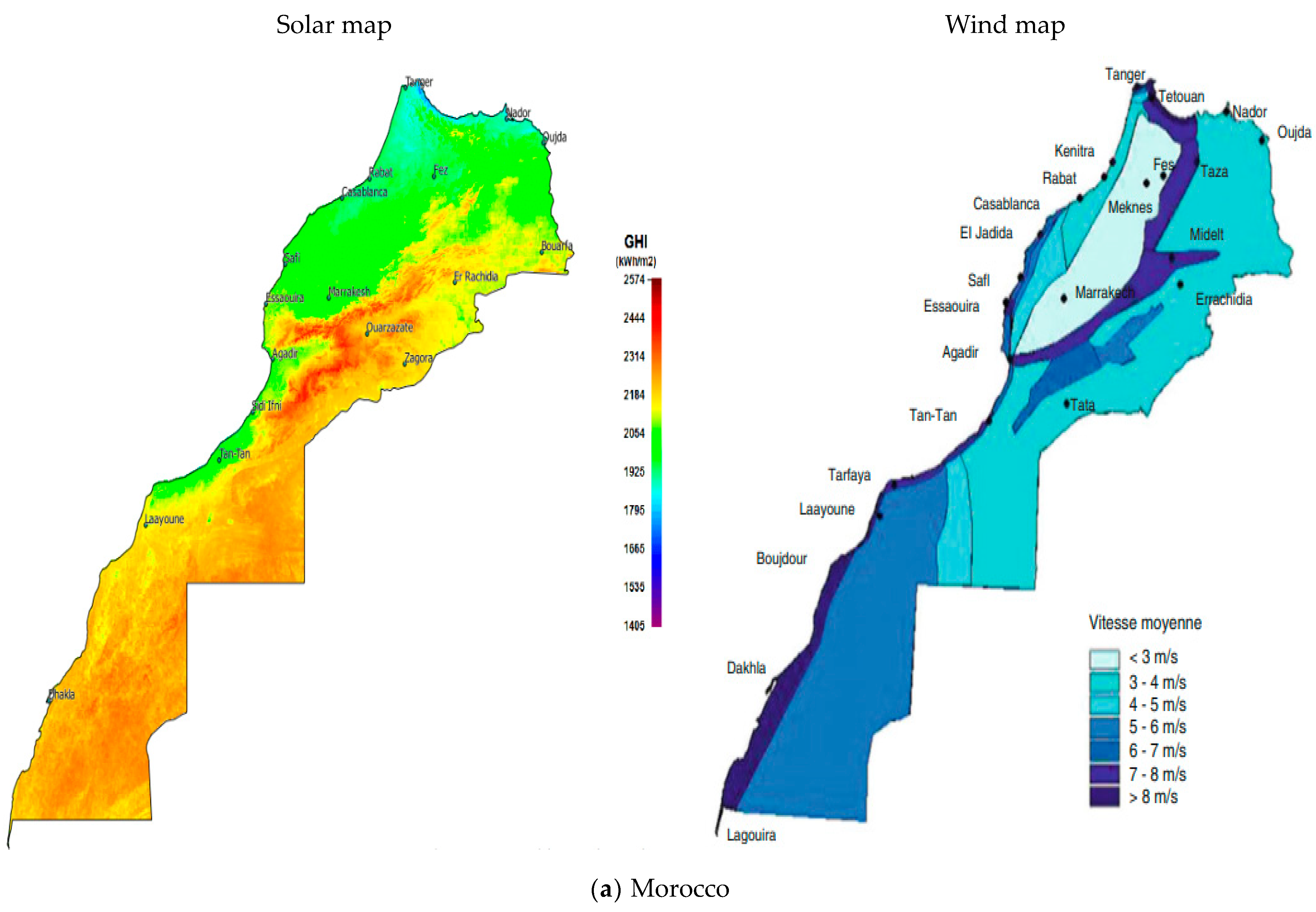
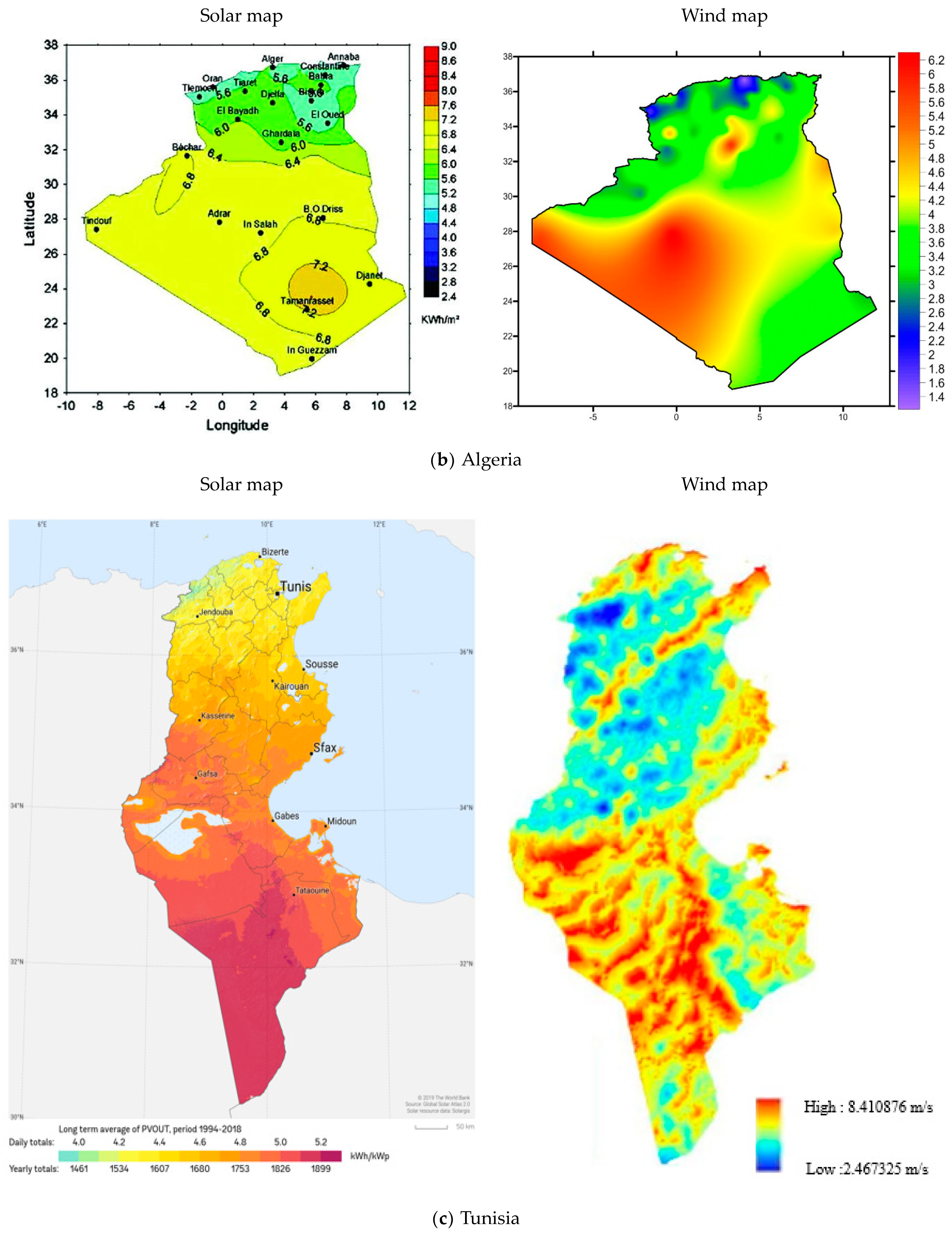
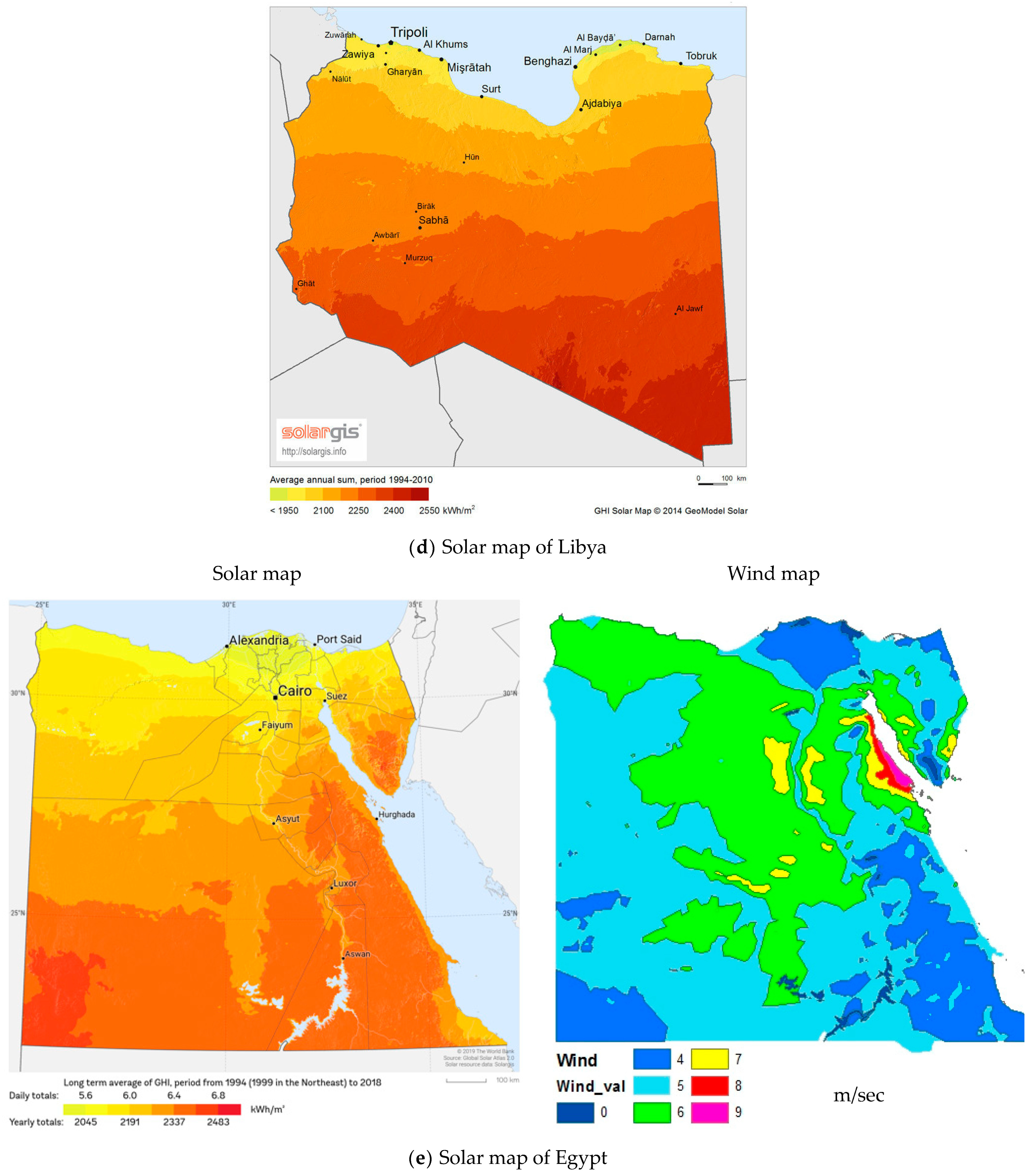
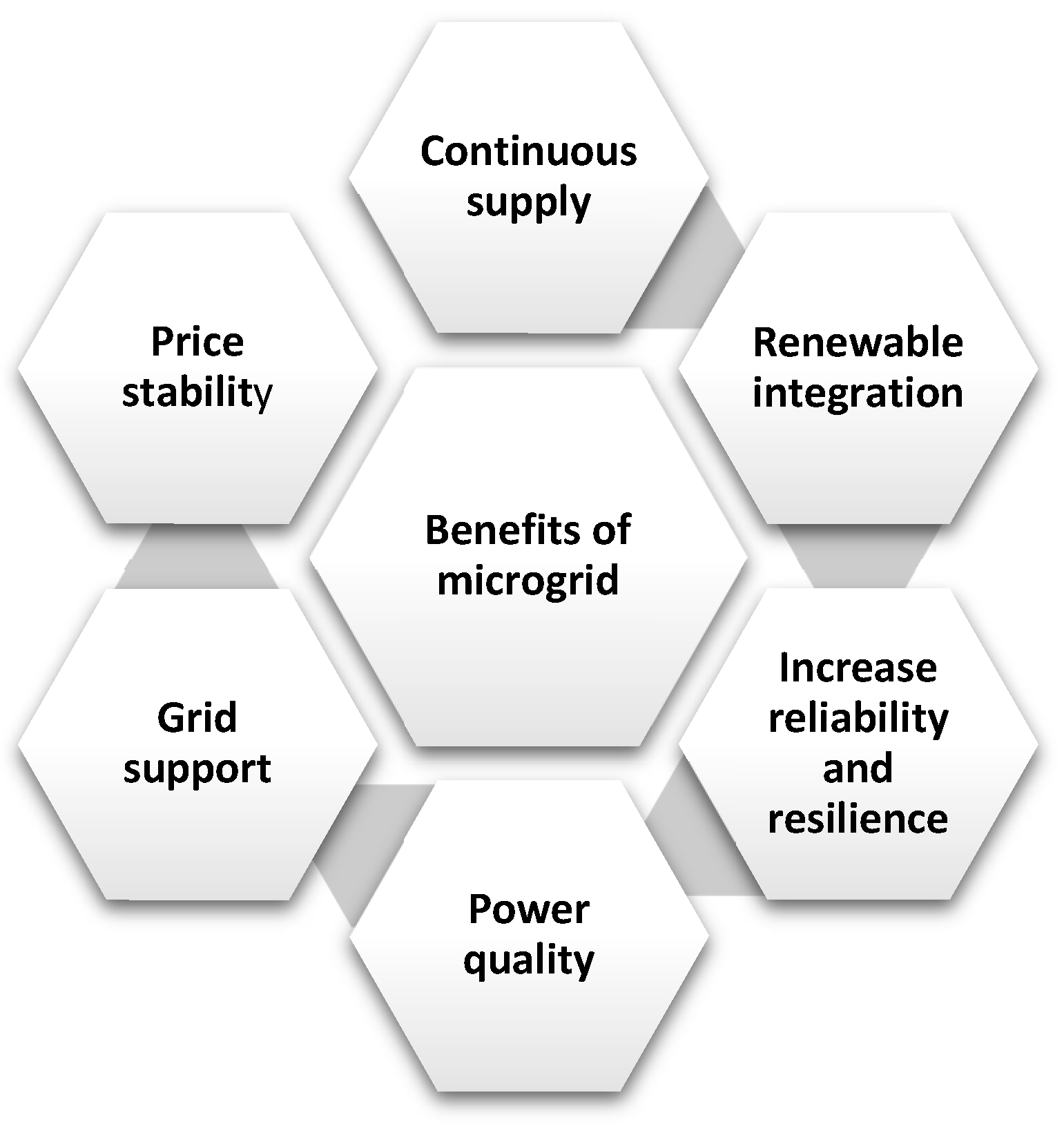

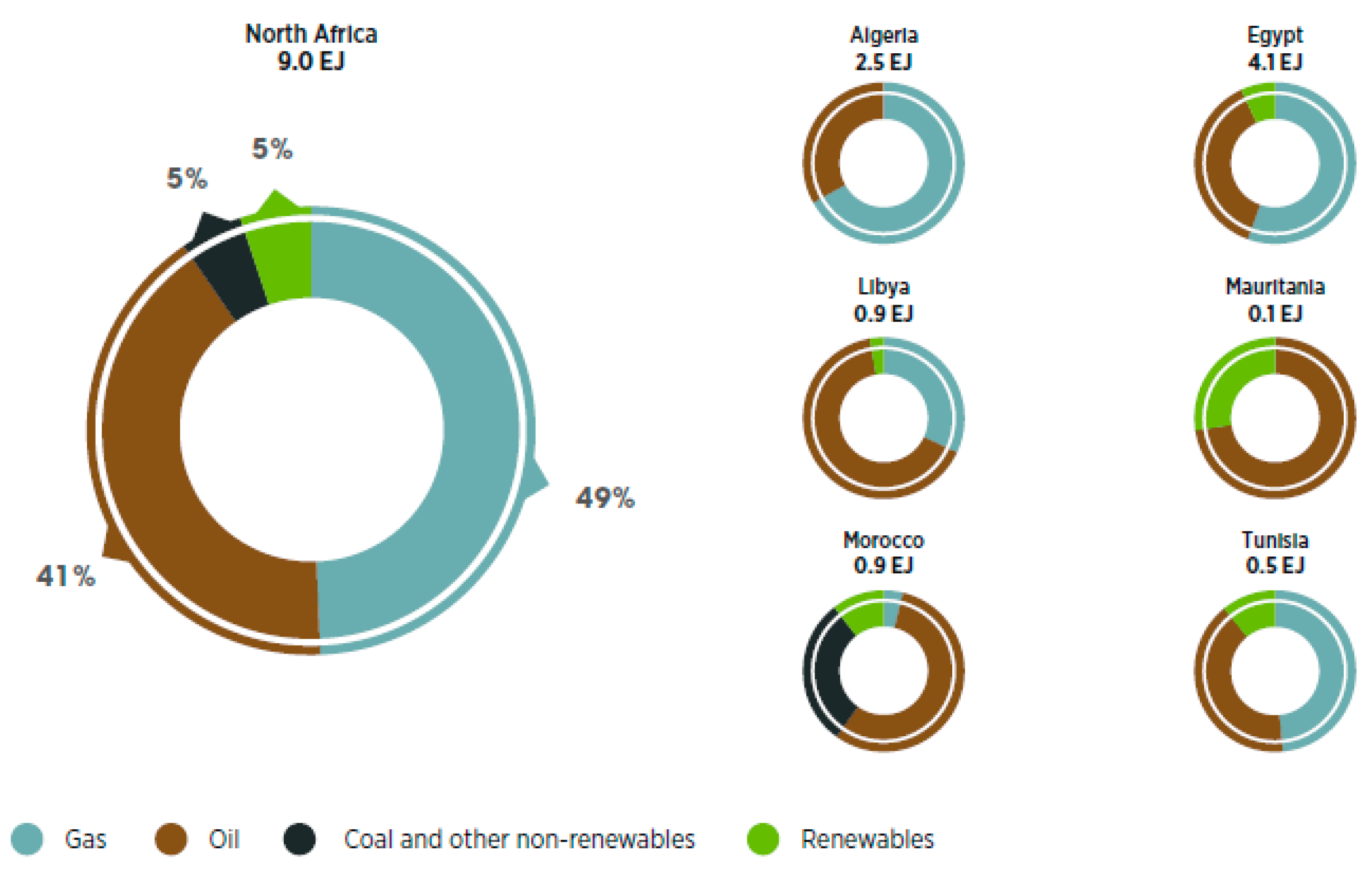
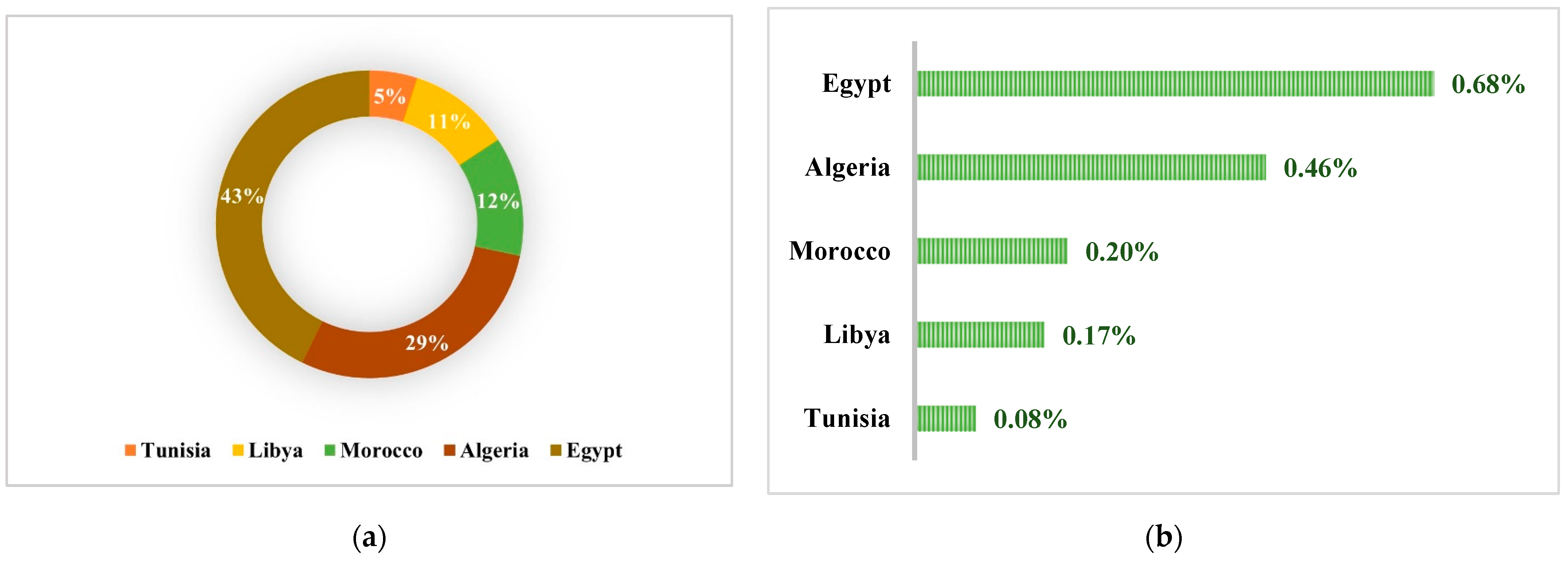
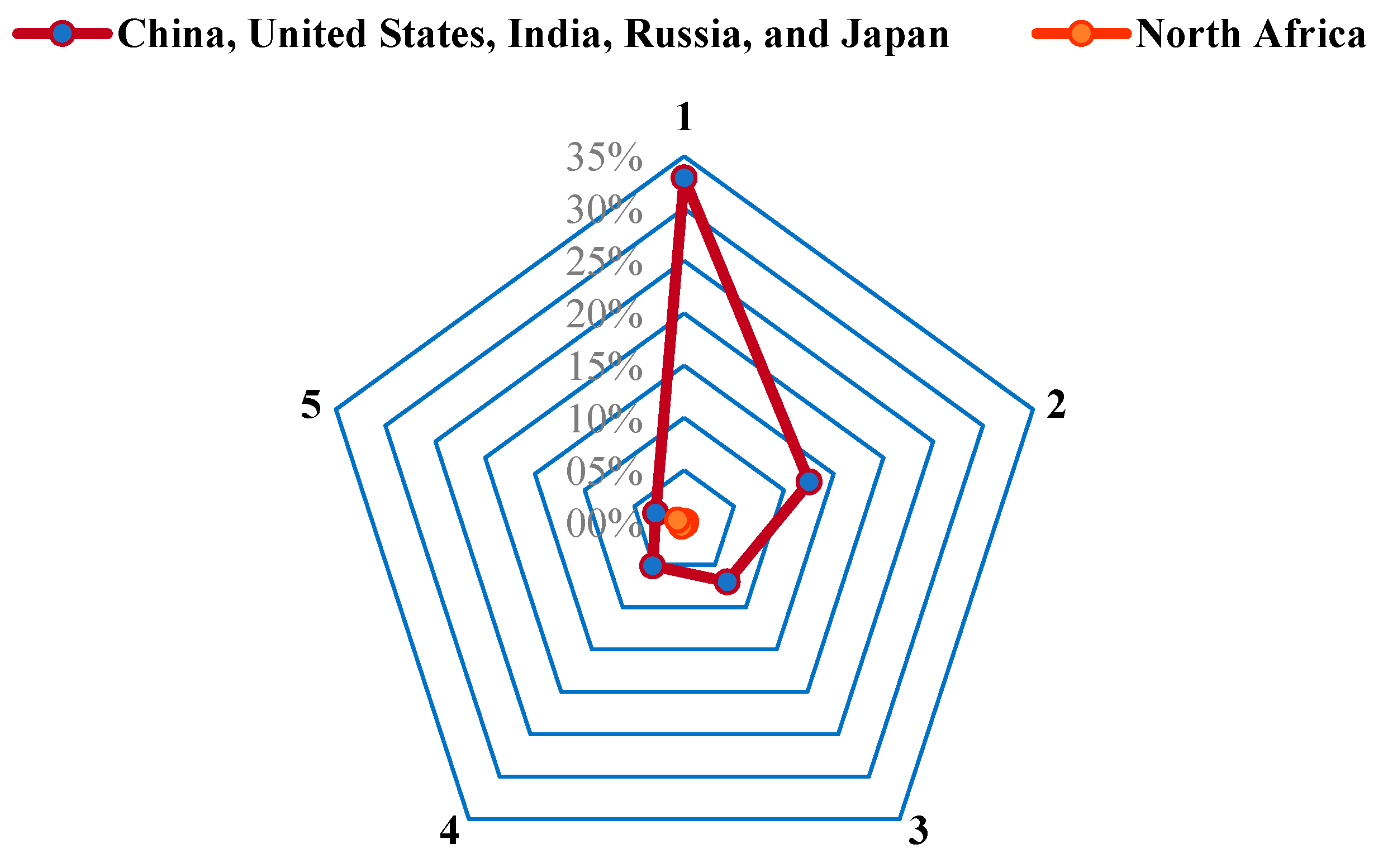
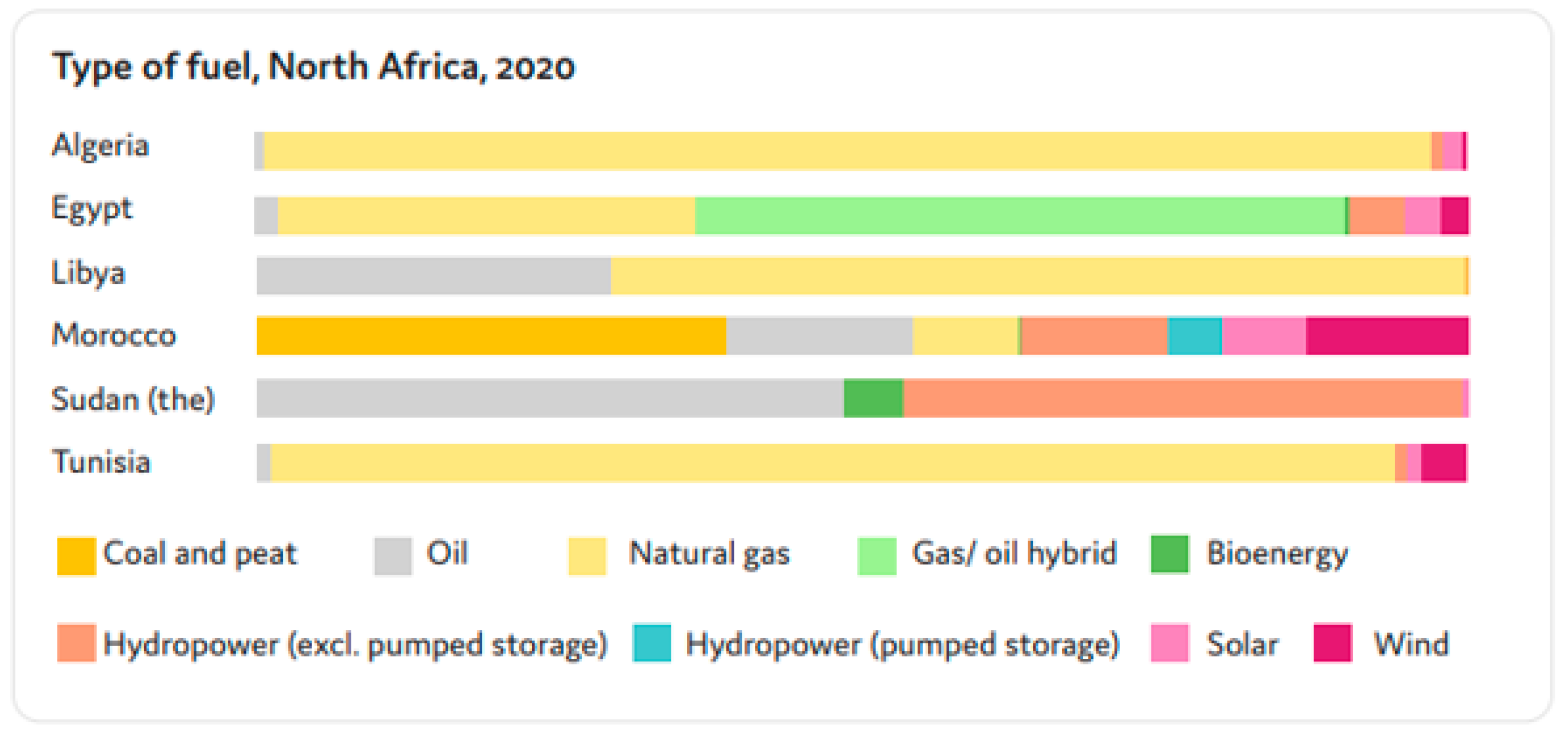


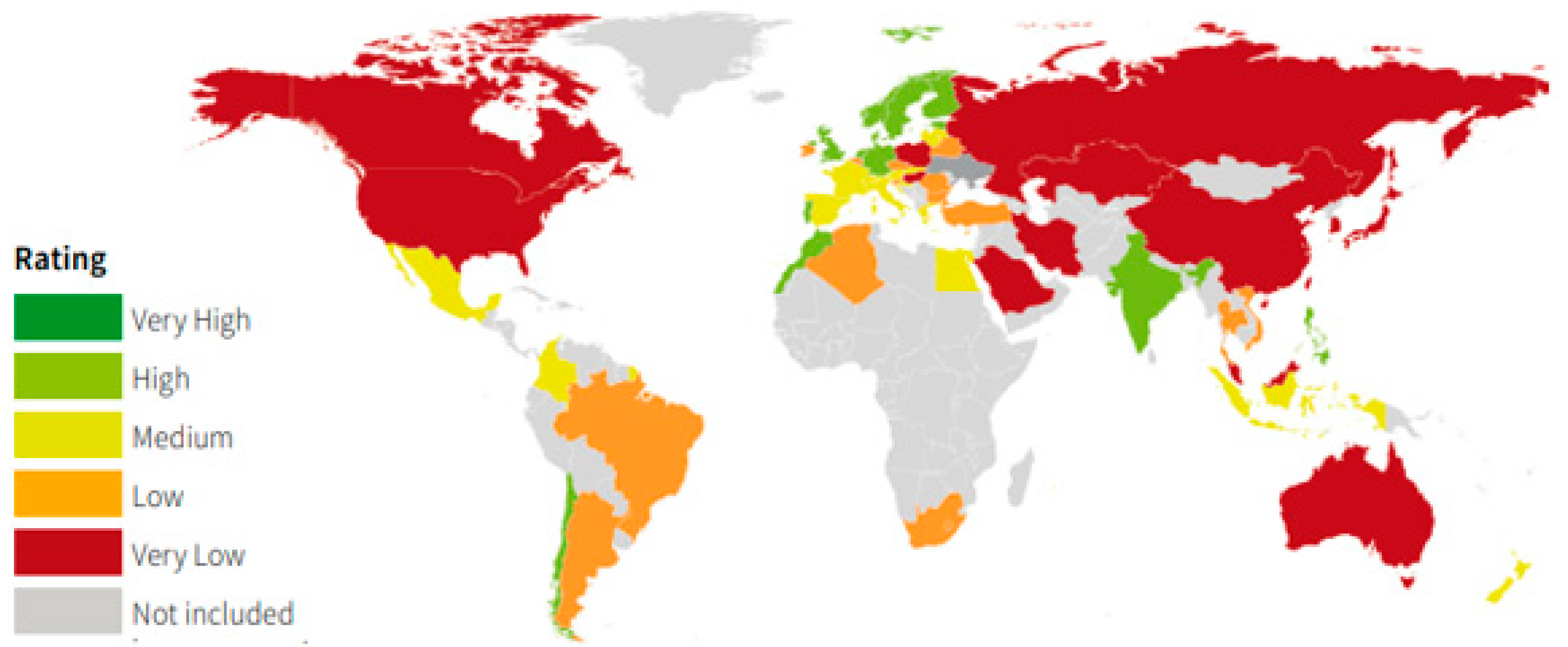
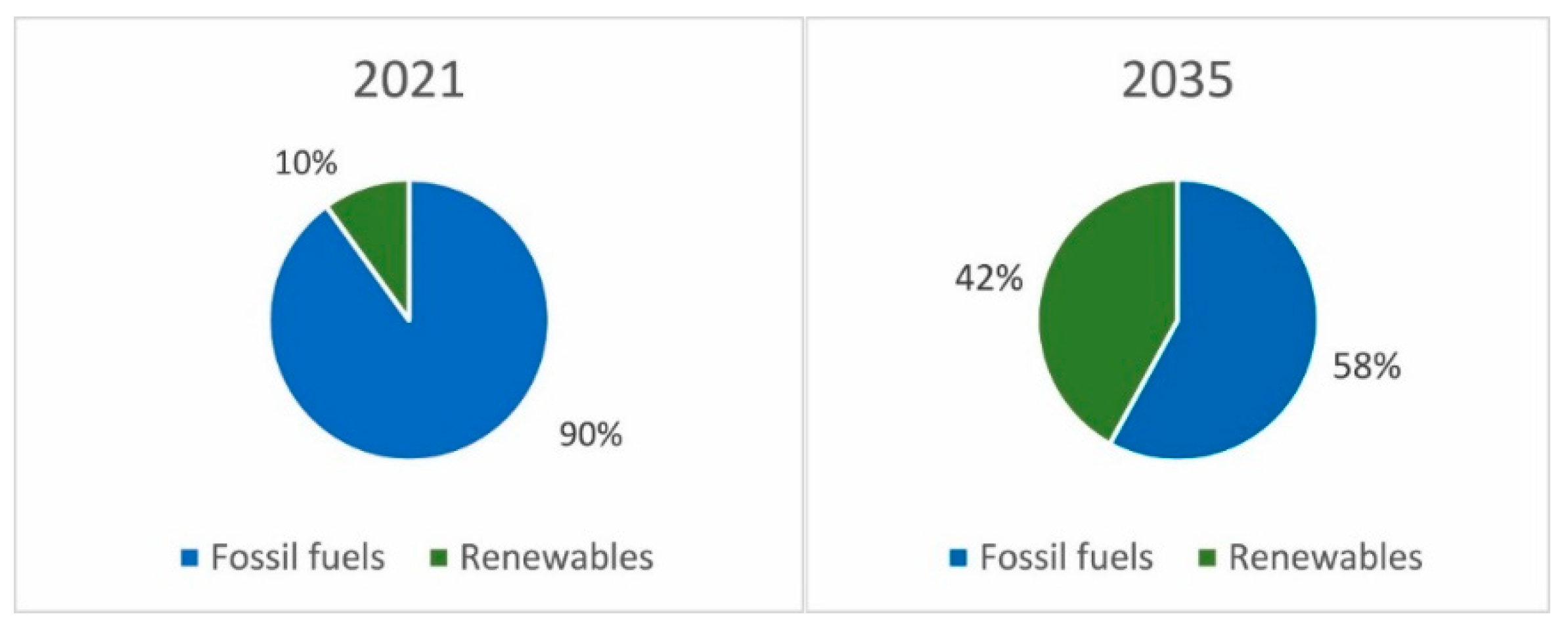
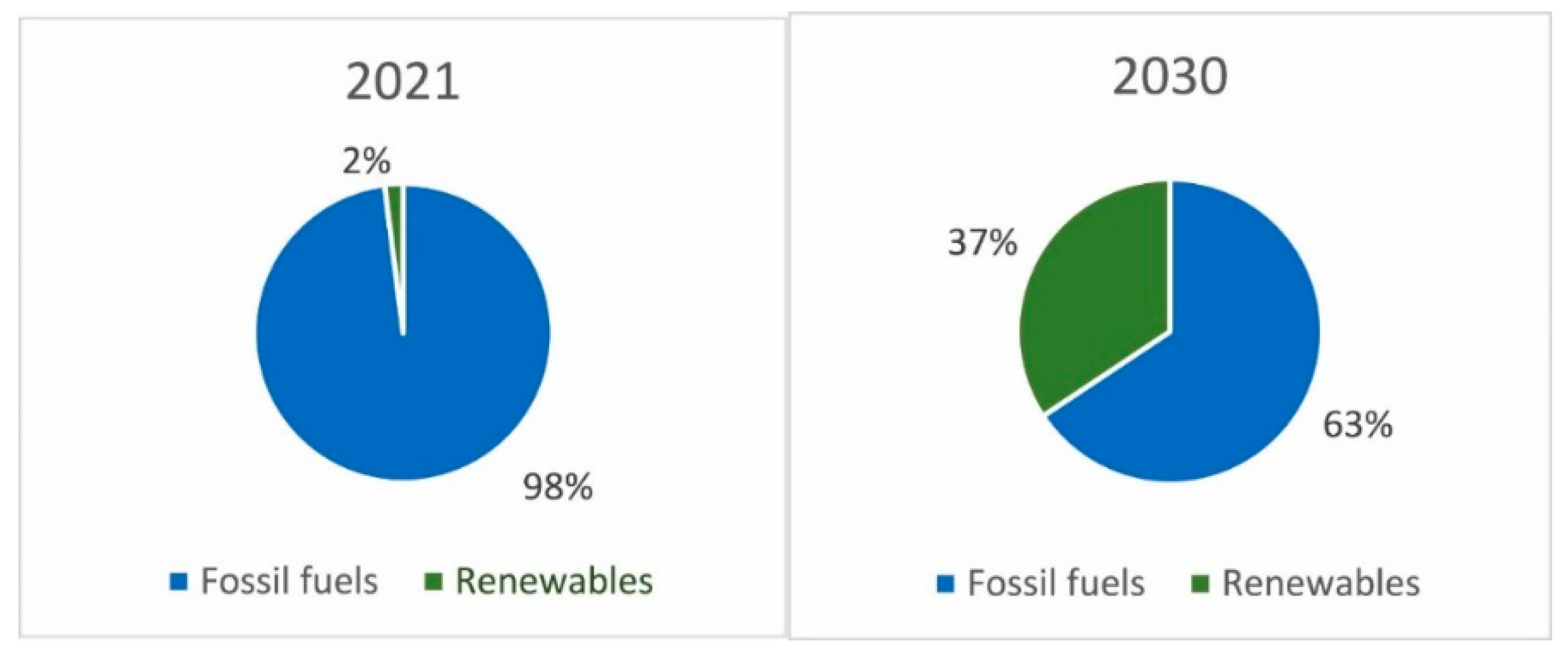
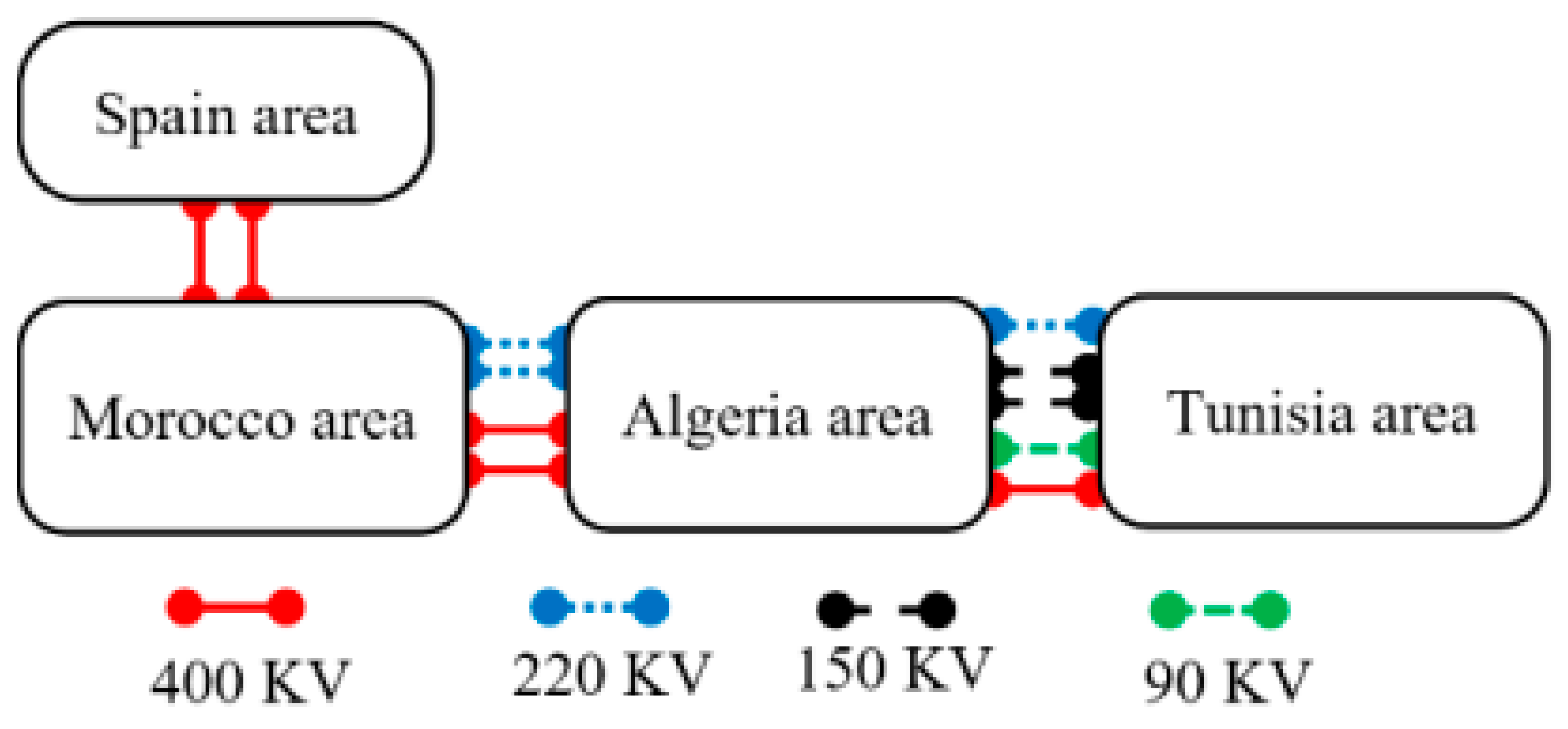
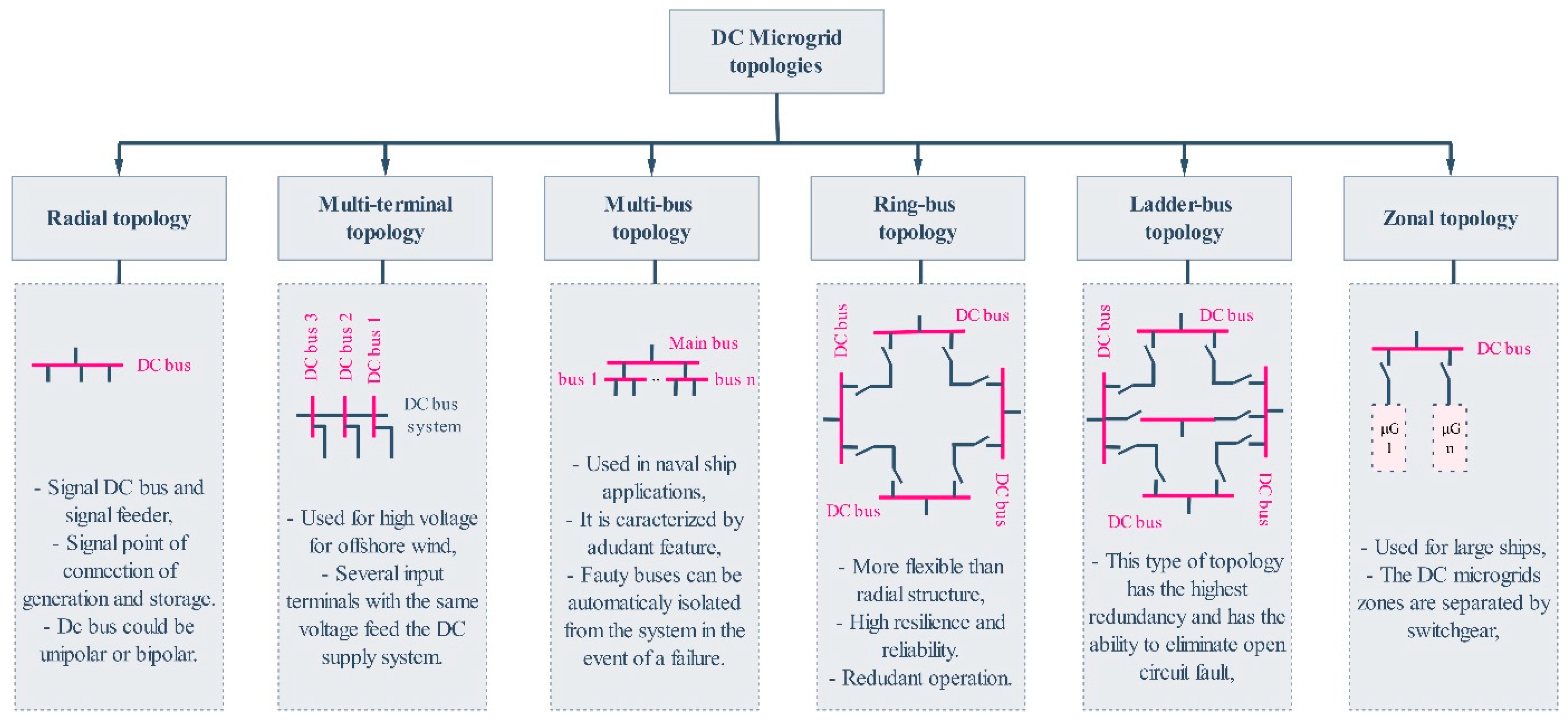
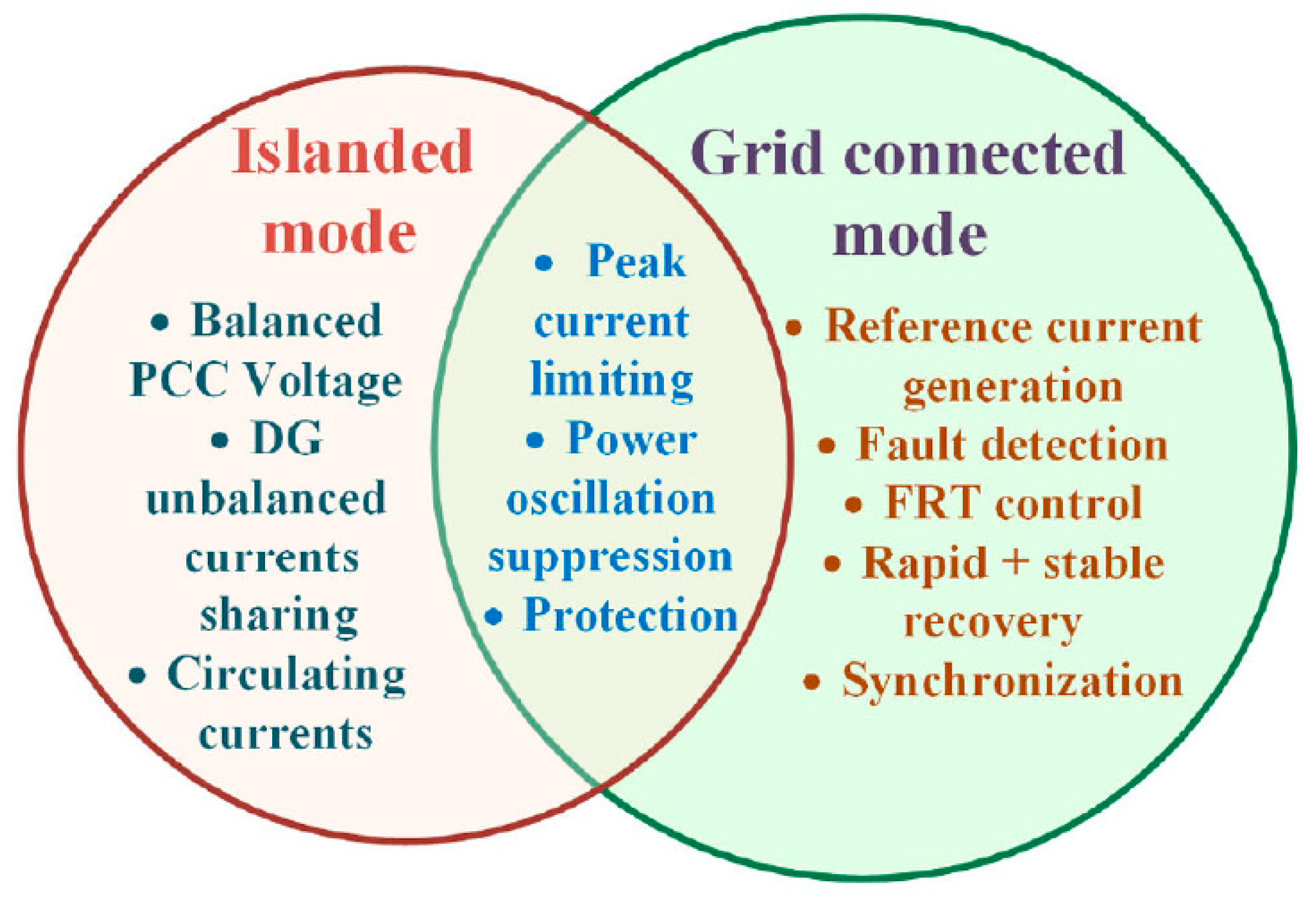
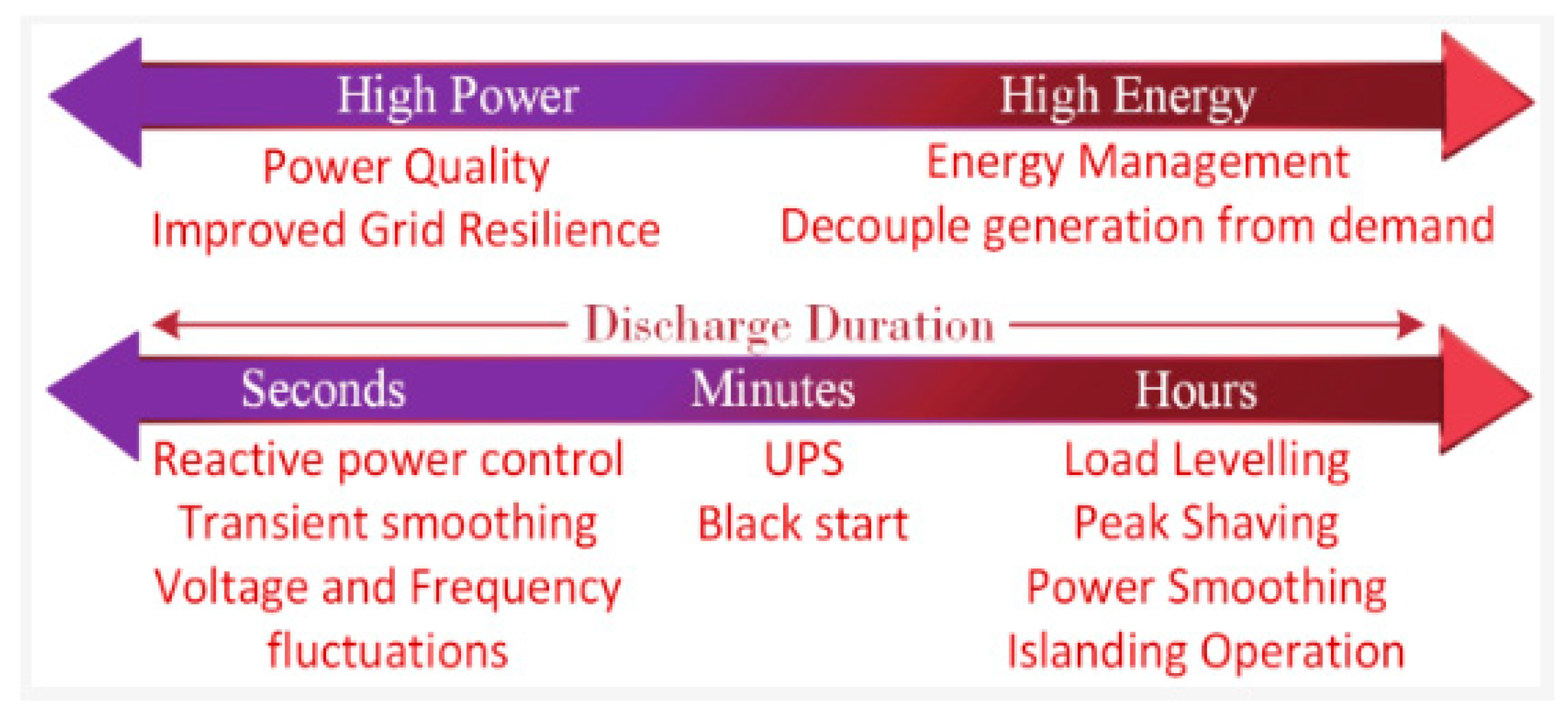
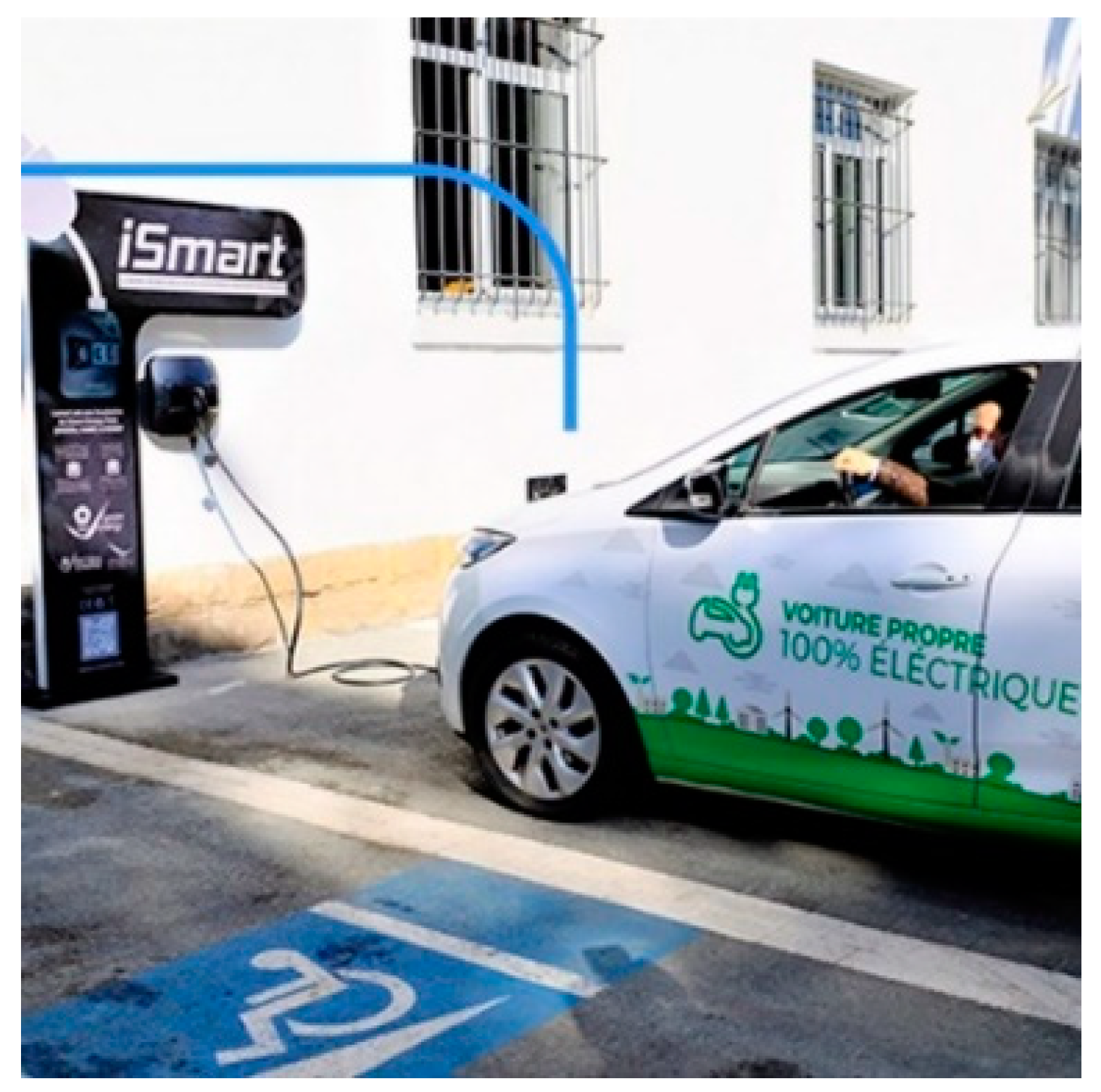

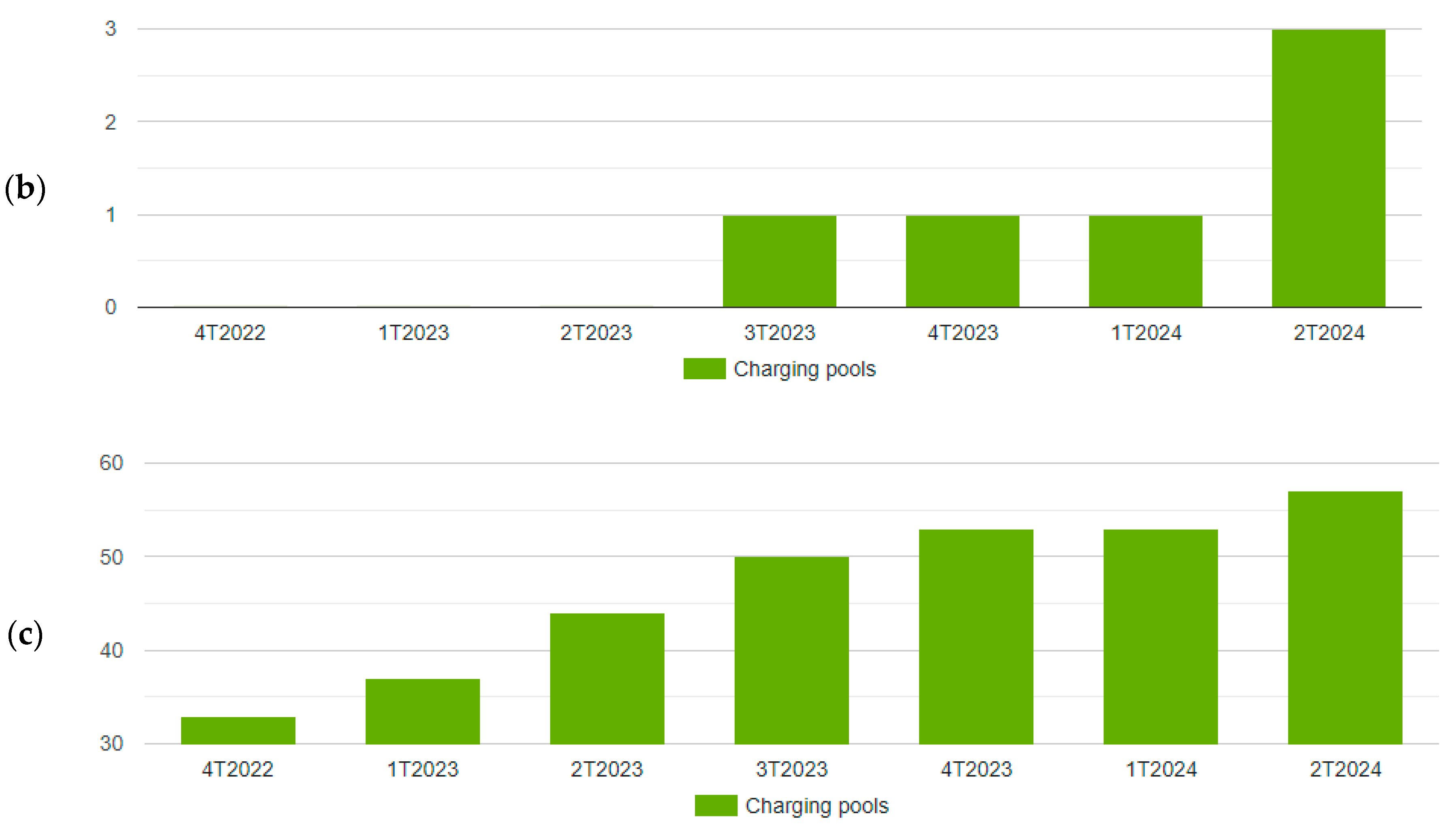
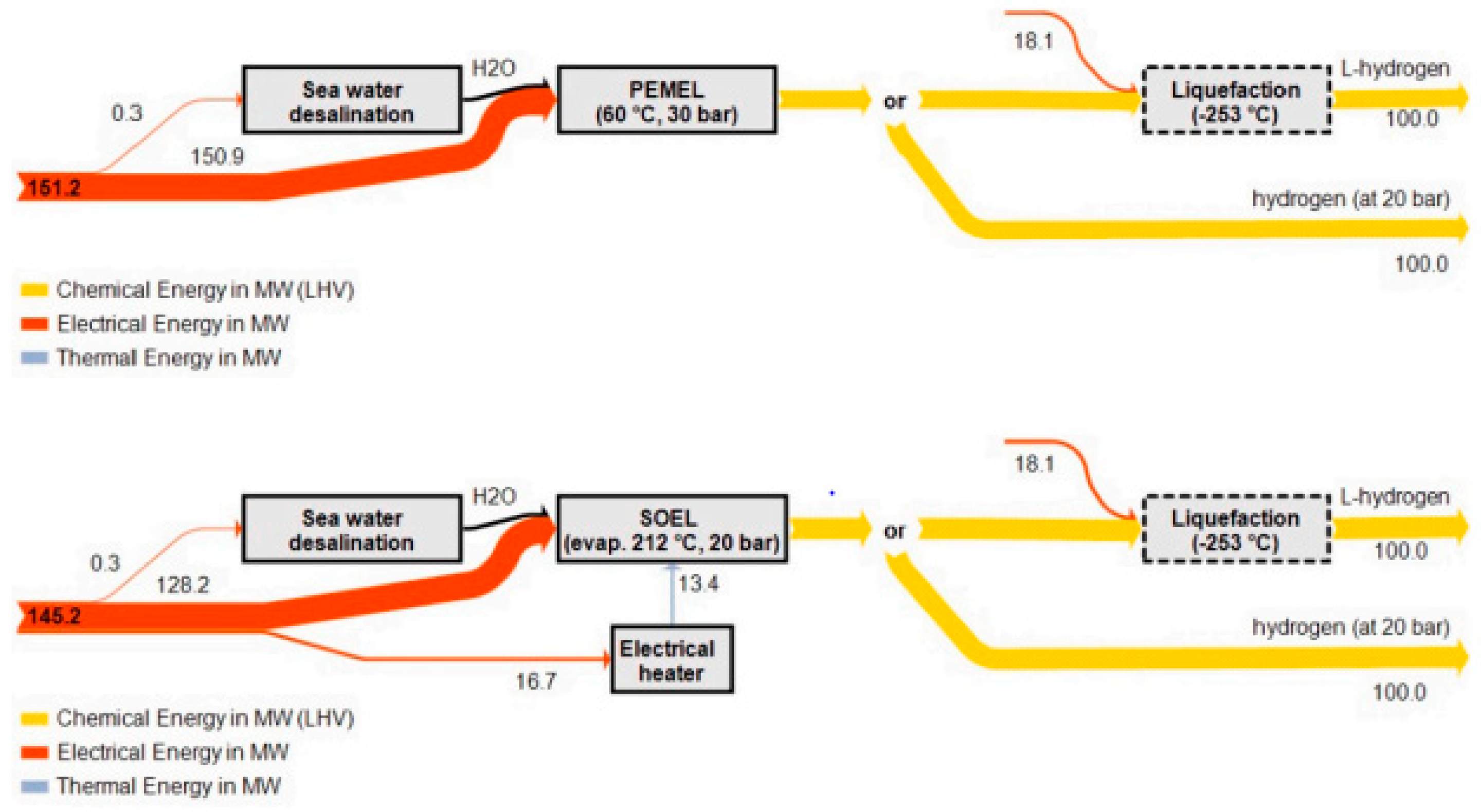

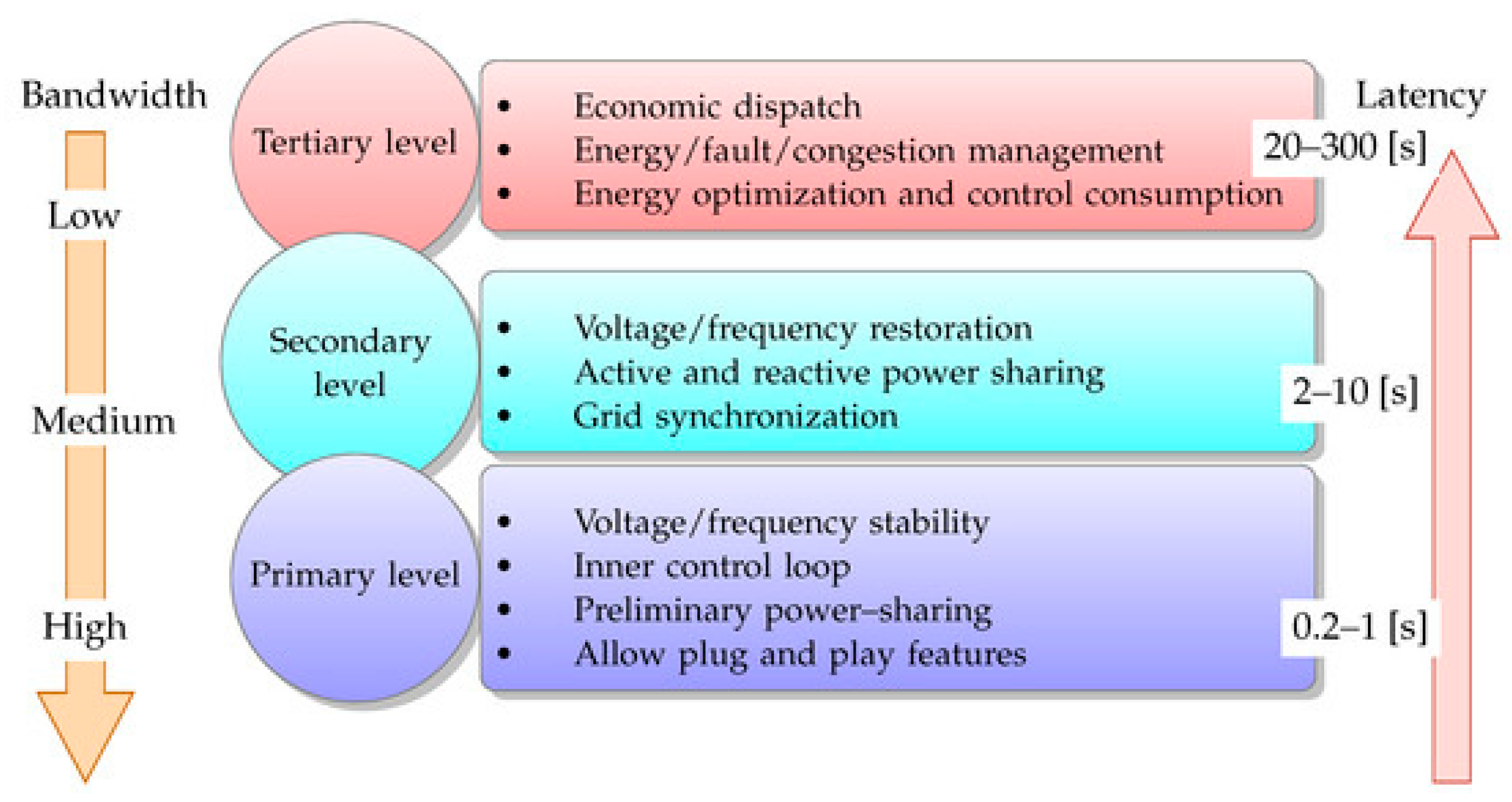
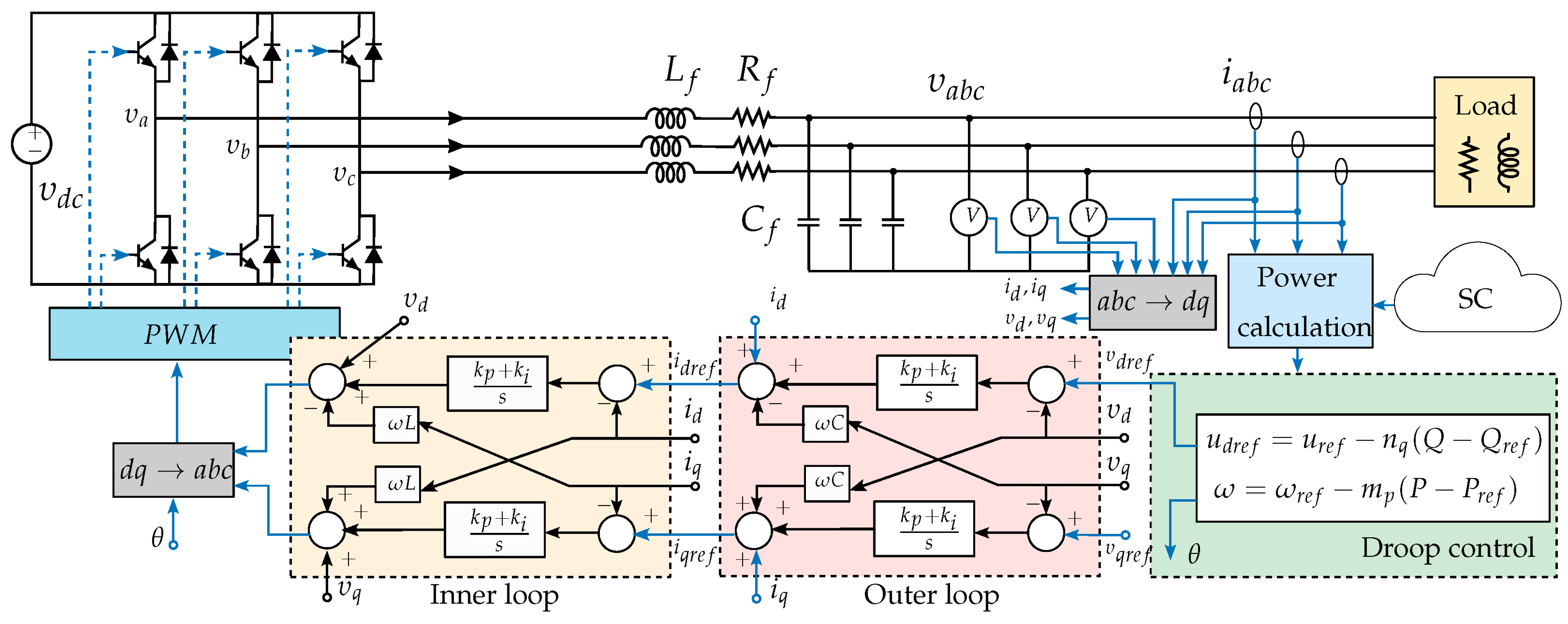
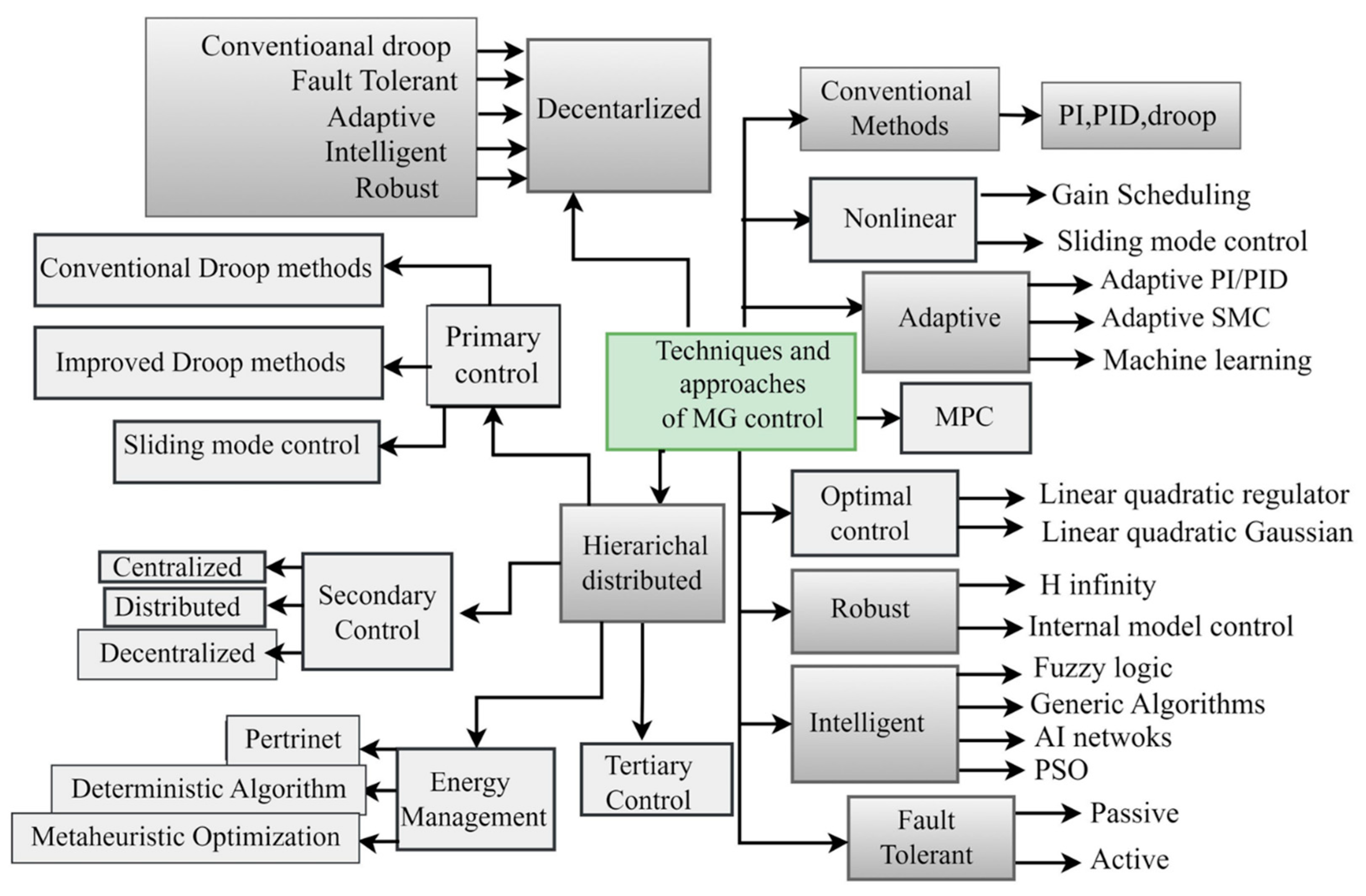
| Technology | Type | Invention Date [49] | Response Time [50] | Advantages [51] | Drawbacks [51] |
|---|---|---|---|---|---|
| Compressed Air Energy Storage | Mechanical | In 1978, Germany developed the world’s first compressed air energy storage plant. | 1–15 min | High capacity | Need for fuel and underground cavities. |
| Pumped Hydro Storage | Mechanical | 1907 was the first use of pumped storage | s–min | High capacity | Geographical restrictions |
| Thermal Energy Storage: Hot-water storage; Molten-salt energy storage; Phase change material storage (PCM); and Thermochemical Energy Storage (TCES). | Thermal | - | High energy density | Lower efficiency | |
| Hydrogen storage and synthetic natural gas (SNG) | Chemical | The history of hydrogen started in 1766. | - | Minor environmental issues. | High investment costs. |
| Hydrogen Fuel cell | Chemical | 1839, by Sir William Robert Grove | <1 s | Long term storage | expensive catalyst |
| flyweel | mechanically store energy as kinetic energy | 1883, by John A. Howell | <4 ms–s | High power and efficiency | Lower energy density |
| Electrochemical |
| - 5–10 ms ms 1 ms 20 ms–s - - | Higher power and energy density | Cycle life. Temperature Dependent |
| Capacitor | Electrical | ms | Fast reponse | Lower efficiency | |
| Supercapacitor | Electrical | 1982 by the Pinnacle Research Institute | 8 ms | High efficiency | Low energy density |
| Superconducting magnetic energy storage | Electrical | <100 ms | High effiicency | Impact on health |
| Country | Transport Sector Emissions Pollutants | Reference |
|---|---|---|
| Morocco | 30% | [53] |
| Algeria | 33.33% | [54] |
| Tunisia | 25.8% | [55] |
| Libya | 30.7% | [56] |
| Egypt | 32% | [57] |
| Feature | Centralized | Decentralized | Hierarchical |
|---|---|---|---|
| High resilience | × | ✓ | ✓ |
| Central controller | ✓ | × | ✓ |
| Low cost | × | ✓ | ✓ |
| High flexibility | × | ✓ | ✓ |
| High coordination | ✓ | × | ✓ |
| Easy implementation | ✓ | ✓ | ✓ |
| Primary | Secondary | Tertiary | |
|---|---|---|---|
| Objective | Maintain voltage and frequency stability at the DER level | Restore voltage and frequency deviations caused by primary control actions | Handle supervisory tasks, such as economic optimization, energy management, and demand response programs |
| Responsiveness | Fastest response time (milliseconds) | Slower response time (seconds to minutes) | Slowest response time (minutes to hours) |
| Mechanisms | Droop control, inverter control | Communication-based control and adaptive control | Optimization algorithms, decision-making tools |
| Role | Ensures fast power sharing among DERs to respond to sudden changes in generation or load | Coordinates power dispatch among DERs to optimize energy consumption and minimize operational costs. | Interacts with the main grid for energy exchange and backup power, ensuring long-term economic and operational efficiency |
| Control Technique | Level | Advantages | Drawbacks | References |
|---|---|---|---|---|
| PID control | Primary | Simple to implement, effective for maintaining voltage and frequency stability | May not handle complex dynamics and uncertainties | [111,113] |
| Droop control | Primary | Simple, robust, and balanced power sharing among DERs | May not provide precise voltage and frequency regulation | [105,112,140] |
| LQR | Primary | Optimal performance, can handle complex dynamics and uncertainties | Requires an accurate system model and knowledge of system parameters | [114,115] |
| Sliding mode control | Primary | Robust to disturbances and uncertainties | Complex to implement, May require a high switching frequency | [116,117] |
| Backstepping | Primary | Can handle complex nonlinear dynamics | Complex to design and requires an accurate system model | [141,142] |
| ADRC | Primary | Robust to disturbances and uncertainties and can handle complex dynamics | Requires careful selection of parameters | [137,138,139] |
| Consensus dispatch optimization | Secondary | Enables decentralized and coordinated power dispatch among DERs | May require extensive communication between DERs | [143,144] |
| Virtual impedance | Secondary | Robust to disturbances and uncertainties, Enables decentralized voltage regulation | Requires communication between DERs | [140,145] |
| VSG (Virtual Synchronous Generator) | Secondary | It emulates the behavior of a synchronous generator, providing inertia and damping | Requires an accurate system model and knowledge of system parameters | [146,147] |
| PSO | Secondary | Optimizes power dispatch and can handle complex dynamics | Computationally demanding, you may get stuck in local optima | [124,125] |
| GA (Genetic Algortithms) | Secondary | Optimizes power dispatch, can handle complex dynamics | Computationally demanding, may not converge to the global optimum | [148,149] |
| MPC | Primary and Secondary | Optimal performance, Can handle complex dynamics and uncertainties | Computationally demanding, requires an accurate system model | [118,119] |
| Adaptive control | Primary and Secondary | Adapts to changing operating conditions | Complex to implement, and may require extensive training data | [130,131,132,133] |
| Fuzzy logic control | Primary and Secondary | Can handle nonlinear dynamics and uncertainties | Requires careful design of fuzzy rules | [126,127] |
| Neural network control | Secondary | Can learn complex relationships from data | Requires large amounts of training data and may be difficult to interpret | [128,129] |
| H-infinity control | Primary and Secondary | Robust to disturbances and uncertainties | Complex to design, requires accurate system model | [134,135] |
| Decentralized economic dispatch | Secondary and Tertiary | Simple to implement, scalable | May not achieve optimal performance | [150,151] |
| Multi-agent systems | Tertiary | Can handle complex interactions among DERs | Complex to design and requires coordination between agents | [152,153] |
| Event-triggered control | Secondary and Tertiary | Reduces communication overhead | May not be suitable for systems with strict latency requirements | [154,155] |
| Game theory-based approaches | Tertiary | Model strategic interactions among DERs for resource allocation | May be challenging to implement in real-time applications | [156,157] |
| Demand response management | Secondary and Tertiary | Coordinates energy consumption patterns to balance supply and demand | May require behavioral changes and incentives for consumers | [158] |
| Deep reinforcement learning | Tertiary | Can learn optimal control strategies from data | Requires large amounts of training data and may be difficult to interpret | [159,160] |
| Decentralized consensus control | Secondary and Tertiary | Enables resilient operation in the presence of communication failures | May not achieve optimal performance due to limited information exchange | [161,162] |
| Distributed optimization algorithms | Secondary and Tertiary | Enables collaborative decision-making among DERs | May require extensive computational resources | [163] |
Disclaimer/Publisher’s Note: The statements, opinions and data contained in all publications are solely those of the individual author(s) and contributor(s) and not of MDPI and/or the editor(s). MDPI and/or the editor(s) disclaim responsibility for any injury to people or property resulting from any ideas, methods, instructions or products referred to in the content. |
© 2024 by the authors. Licensee MDPI, Basel, Switzerland. This article is an open access article distributed under the terms and conditions of the Creative Commons Attribution (CC BY) license (https://creativecommons.org/licenses/by/4.0/).
Share and Cite
Naseri, N.; Aboudrar, I.; El Hani, S.; Ait-Ahmed, N.; Motahhir, S.; Machmoum, M. Energy Transition and Resilient Control for Enhancing Power Availability in Microgrids Based on North African Countries: A Review. Appl. Sci. 2024, 14, 6121. https://doi.org/10.3390/app14146121
Naseri N, Aboudrar I, El Hani S, Ait-Ahmed N, Motahhir S, Machmoum M. Energy Transition and Resilient Control for Enhancing Power Availability in Microgrids Based on North African Countries: A Review. Applied Sciences. 2024; 14(14):6121. https://doi.org/10.3390/app14146121
Chicago/Turabian StyleNaseri, Nisrine, Imad Aboudrar, Soumia El Hani, Nadia Ait-Ahmed, Saad Motahhir, and Mohamed Machmoum. 2024. "Energy Transition and Resilient Control for Enhancing Power Availability in Microgrids Based on North African Countries: A Review" Applied Sciences 14, no. 14: 6121. https://doi.org/10.3390/app14146121
APA StyleNaseri, N., Aboudrar, I., El Hani, S., Ait-Ahmed, N., Motahhir, S., & Machmoum, M. (2024). Energy Transition and Resilient Control for Enhancing Power Availability in Microgrids Based on North African Countries: A Review. Applied Sciences, 14(14), 6121. https://doi.org/10.3390/app14146121









